Ohsung Electronics URCTKP9600 Network Keypad User Manual EMISSION TEST REPORT
Ohsung Electronics Co., Ltd. Network Keypad EMISSION TEST REPORT
User Manual

Order Number
: GETEC-C1-18-270
FCC Part 15 Certification
Test Report Number
: GETEC-E3-18-017
Page 1 / 1
EUT Type: Network keypad
FCC ID.: OZ5URCTKP9600
APPENDIX G
: USER’S MANUAL
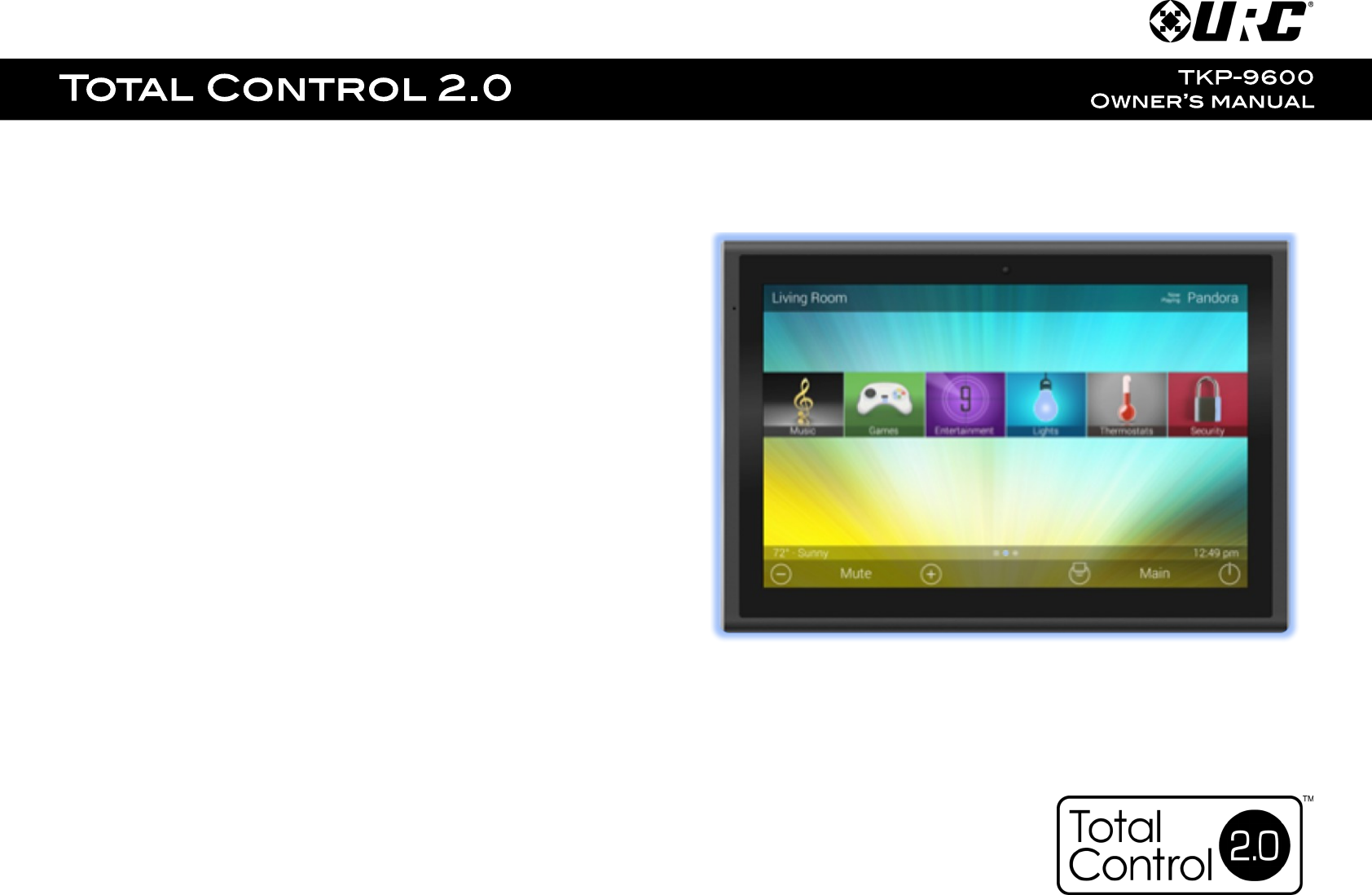
TKP-9600
Owner’s Manual
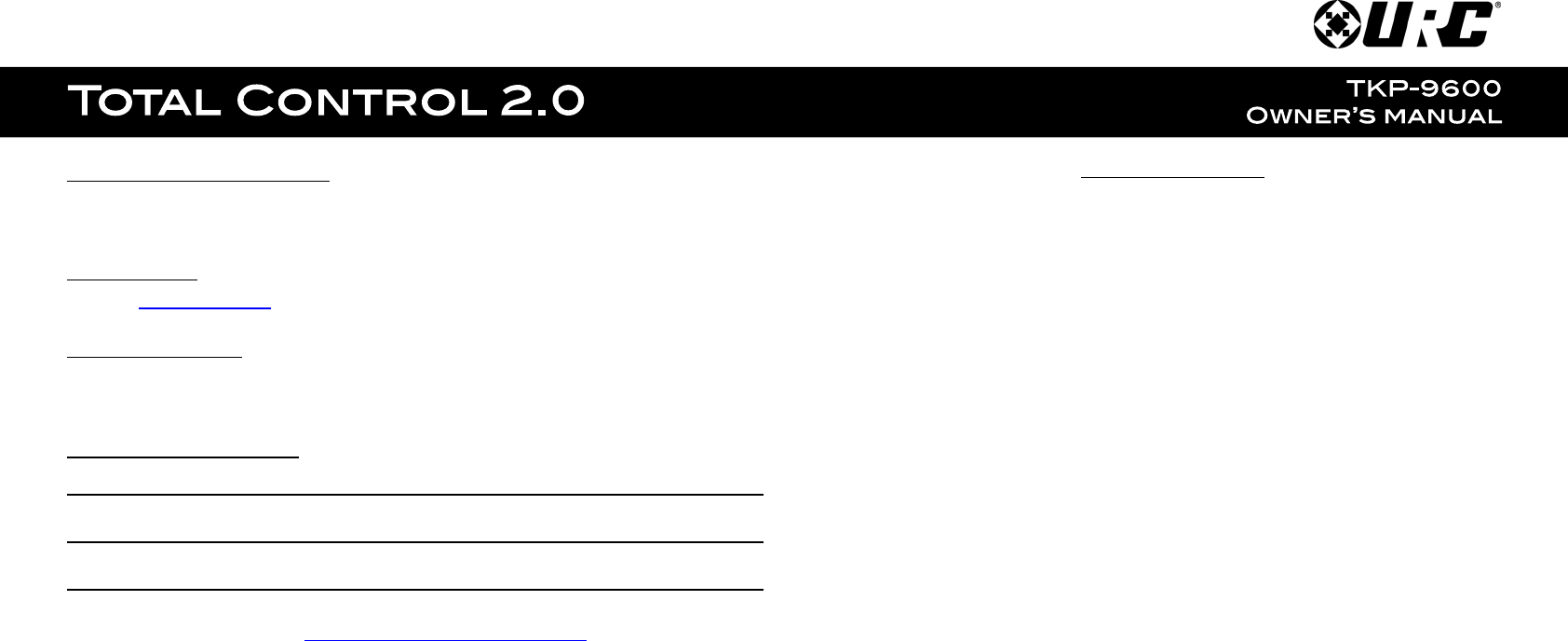
Introducing the TKP-9600
Thank you for purchasing URC’s TKP-9600 In-Wall Network Keypad. Its easy and intuitive
use helps to simplify your life while adding control of more things than thought possible.
Online Help:
Visit the URC Home Page for downloads, training materials, and frequently asked questions.
Contact Support:
Total Control is a URC product sold direct or through distribution. For questions or
assistance contact your Custom Installer/Programmer.
My Installer/Programmer:
or URC Technical Support at: techsupport@universalremote.com
(914) 835-4484
Universal Remote Control, Inc.
500 Mamaroneck Ave
Harrison, New York 10528
Toll Free: (800) 901-0800
Table of Contents
Features and Benefits..........................................................................................1
Parts List.................................................................................................................3
Installation.............................................................................................................4
Main Menu: Navigation.......................................................................................6
Title Bar..................................................................................................................7
Room’s Menu...................................................................................................9
Room Linking.................................................................................................10
Now Playing..................................................................................................11
Core Buttons.........................................................................................................12
Shortcut Popup Menu..................................................................................13
Status Bar......................................................................................................15
Intercom................................................................................................................17
Navigating the Intercom Menu..................................................................19
Making Calls: Audio-Video........................................................................20
Making Calls: Audio Calls..........................................................................22
Making Calls: Baby Monitor......................................................................24
Making Calls: Audio Broadcast.................................................................26
Do Not Disturb Mode...................................................................................28
Scenes Menu.......................................................................................................29
Settings Menu......................................................................................................30
Specifications......................................................................................................39
Limited Warranty Statement.............................................................................39
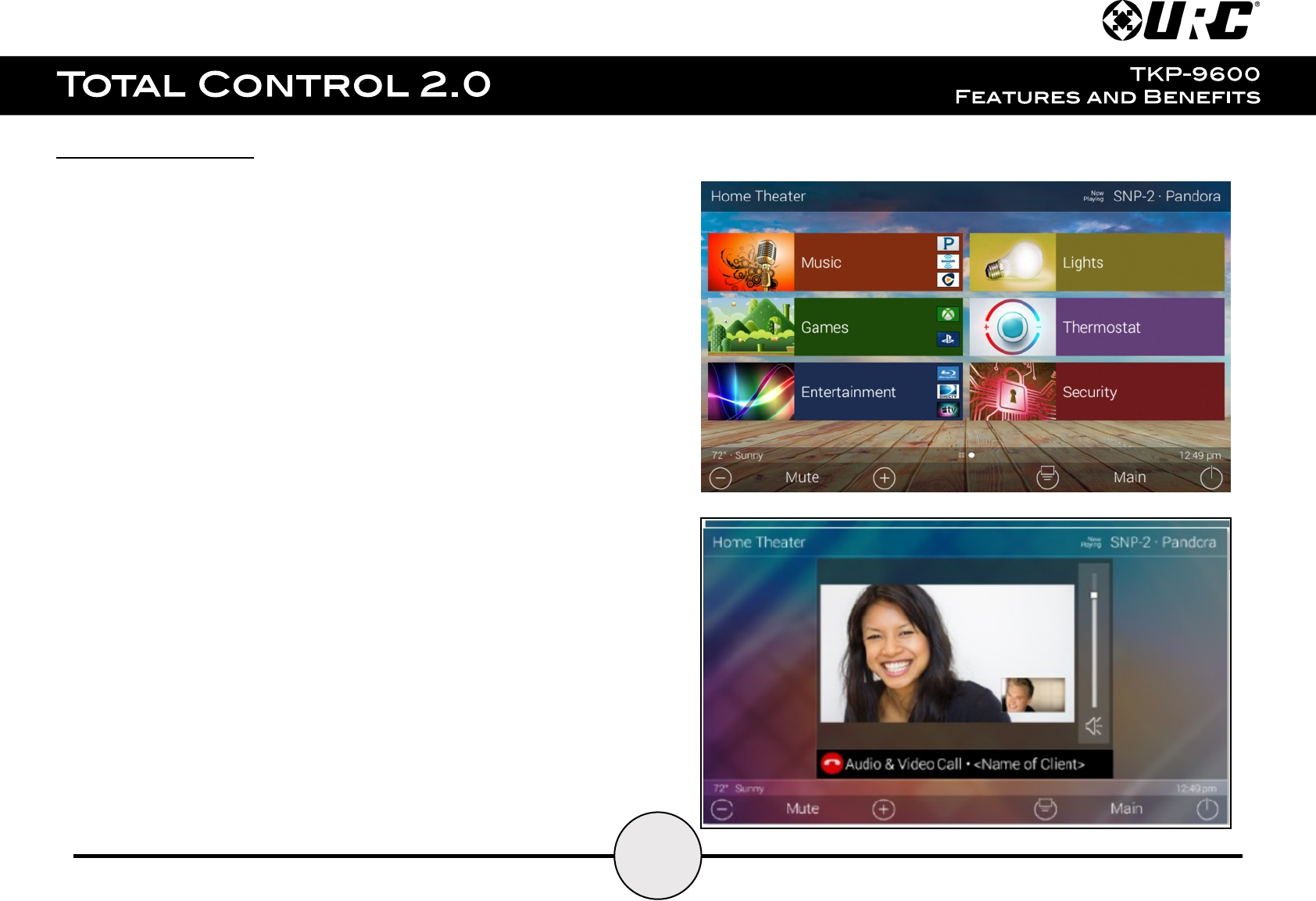
1
Features and Benefits:
The TKP-9600 In-Wall Network Keypad is one of URC’s most advanced devices that is
optimized for usage with Total Control 2.0.
Enjoy these key features:
Updated User Experience:
This device has the capability of using URC’s Total Control 2.0 software suite. Using
this software provides this device with a modern “look and feel” giving the end-user
an improved user experience in terms of graphics, performance, and features.
Audio-Video Interface:
Communicate with any other URC Intercom-Enabled device in the system with this
feature. The end-user can make Audio-Video, Audio, or Baby Monitor calls directly
from the TKP-9600.
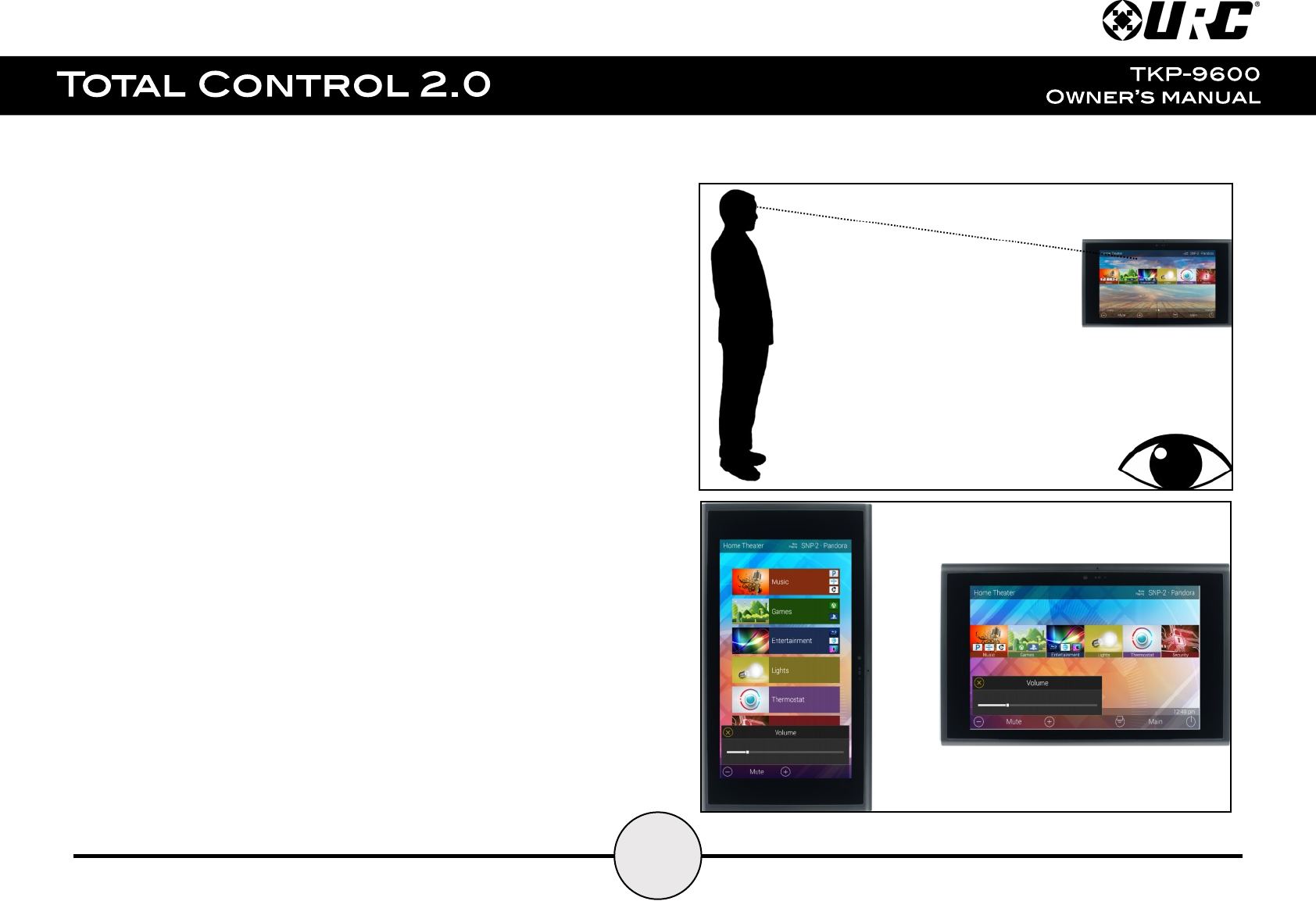
2
Proximity Sensor:
This feature allows the TKP-9600 to spring into action automatically. Utilizing
its proximity sensor, the keypad can detect distances from up to three (3) feet
away. This setting can be adjusted in the device’s Settings menu.
Flexible Orientation:
The TKP-9600 offers the ability to display the device in either portrait or
landscape mode making it the perfect keypad for almost any room. This feature
can only be set from within the Accelerator 2.0 software, speak to a custom
home professional prior to installation.
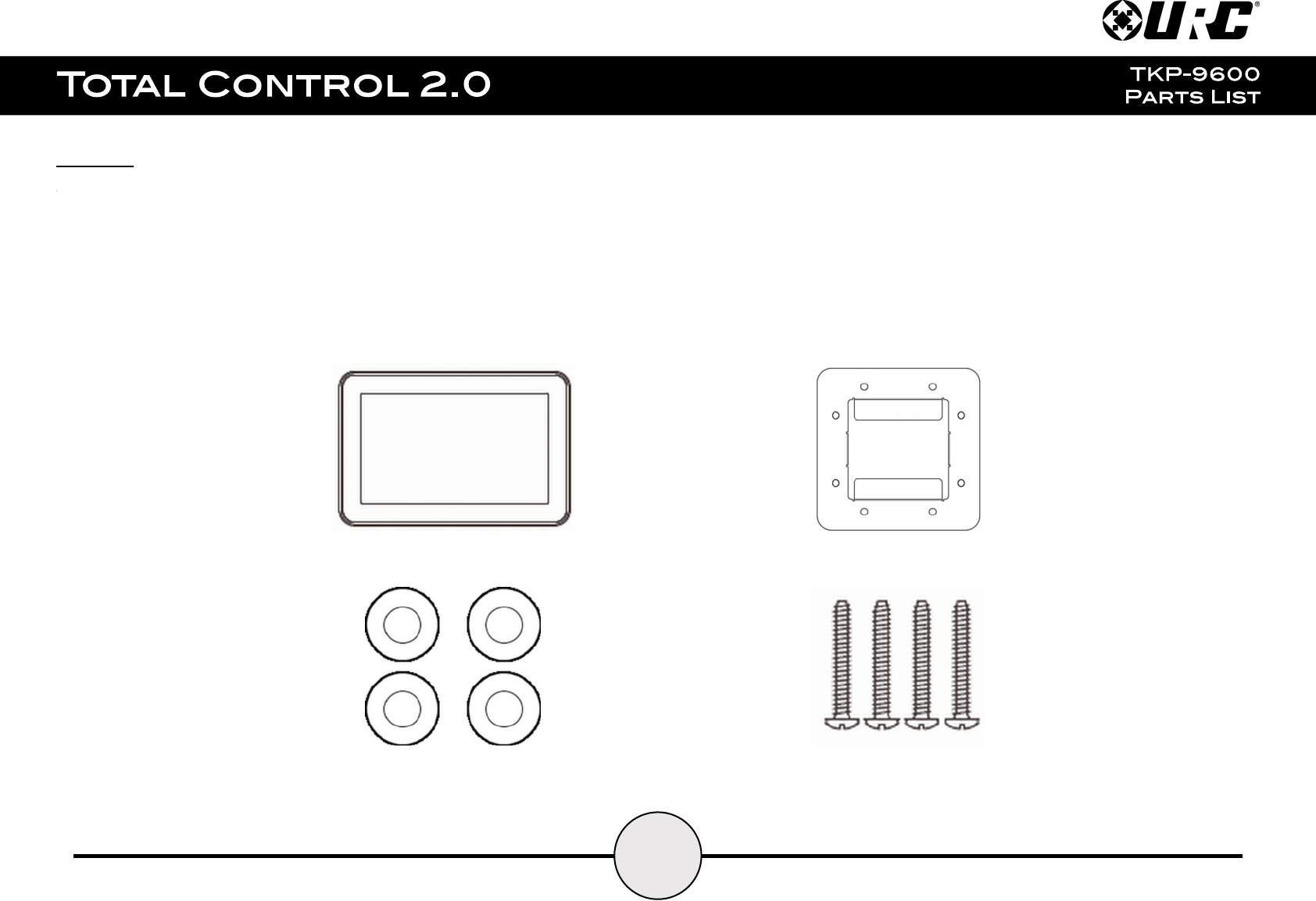
3
Part List:
Included in the TKP-9600:
1x - TKP-9600 Network Keypad
1x - Mounting Ring
4x - Mounting Screws
4x - Spacers
TKP-9600
Mounting Ring
Spacers
Mounting Screws
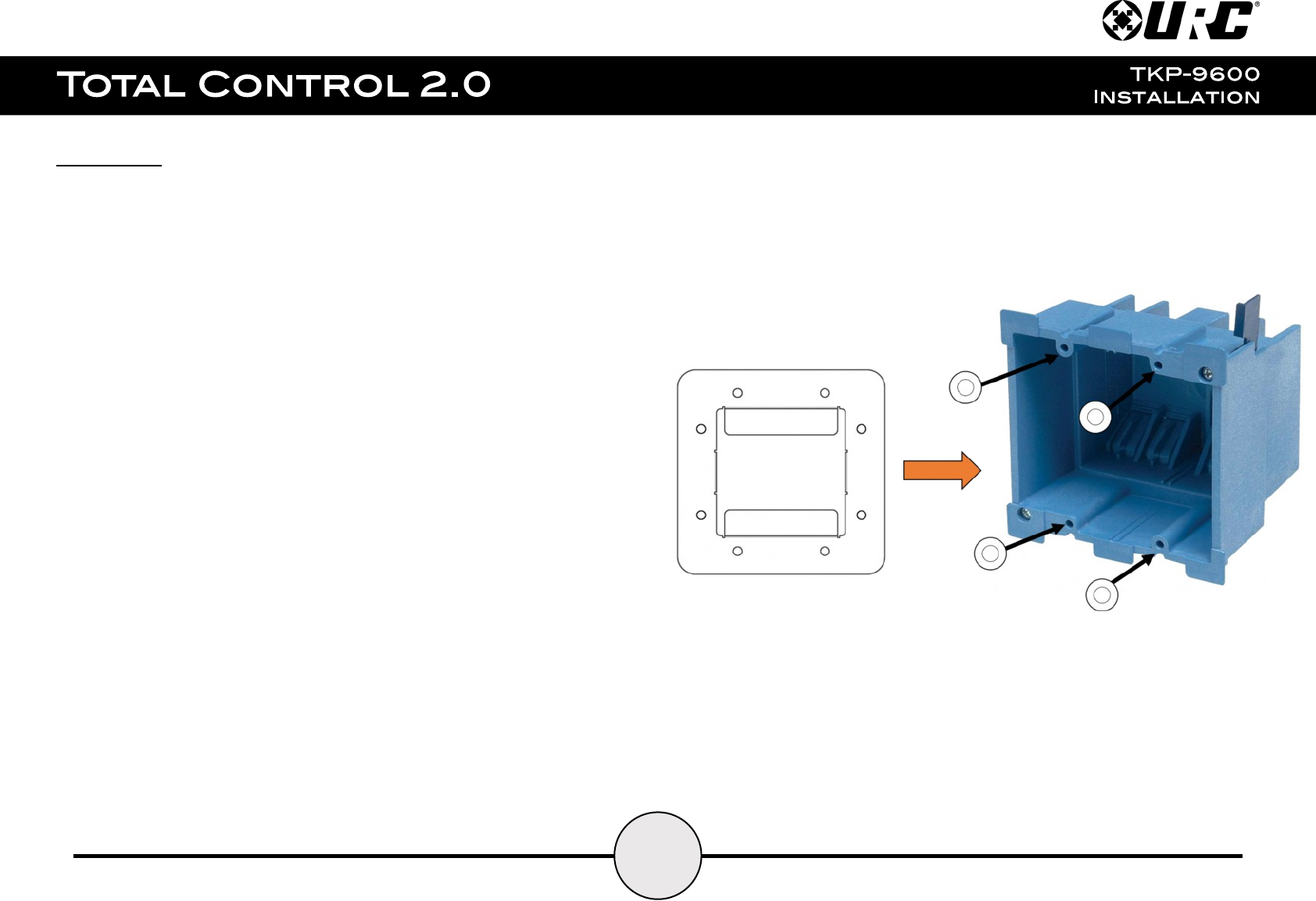
4
Installation:
The TKP-9600 is wall mountable and fits into a standard dual gang (J-box or Mud Ring)
opening. Prior to installation, make sure power is available at the preferred location.
Power can be supplied to the TKP-9600 through an Ethernet (RJ45) cable connected to a
PoE (Power over Ethernet) in either of the following ways:
●Router/Switch
●PoE Injector
Power over Ethernet describes a system that passes electrical power safely, along with
data, along Ethernet cabling. A shielded Ethernet cable is preferred. The IEEE standard
for PoE requires a Category 5 or higher for high power levels.
Using the Spacers:
Use the spacers when installing the mounting ring on to a gang box. The spacers are
NOT needed when using a p-ring.
Included in the box are four (4) spacers that are to be used at specific installation
sites. Most new homes are retrofitted with plaster ring boxes (p-ring) that allow the
TKP-9600 to be mounted flat and flushed to the wall without the user of spacers.
However, in some instances, the only boxes that are in the home are dual-gang
boxes. In those situation spacers are REQUIRED in order to install the TKP-9600.
Use the spacers as a buffer between the mounting ring and the dual-gang box, this
can be done by using a screw to secure the mounting ring to the box.
With this the TKP-9600 can sit flush and flat on its mount without the risk of
bending or breaking the dual-gang box.
Mounting Ring
Spacers
Dual-Gang
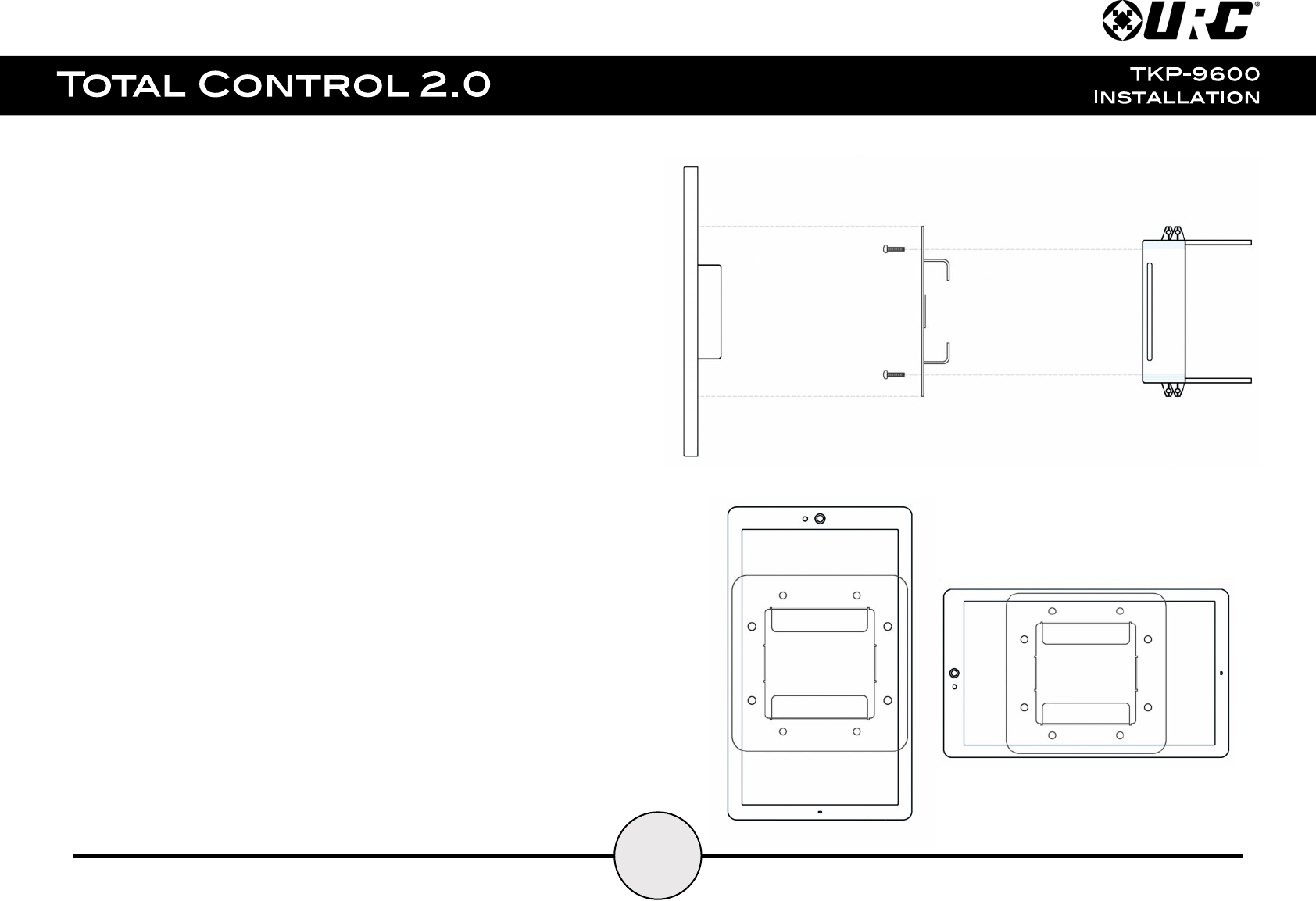
5
Wall Mounting:
Follow the steps below for installation:
1. Assure the dual-gang opening is fitted with the standard two-gang
retro-box (available at almost any electronic supplier).
2. Mount the wall-plate to the two-gang retro-box.
3. Connect the Ethernet cable to the rear of the supplied TKP-9600.
4. The TKP-9600 easily snaps into the wall-plate.
The keypad mount rotates to accommodate landscape or portrait viewing
modes. The viewing mode is set from within the Accelerator 2.0 software.
Mounting Ring
TKP-7600
Dual-Gang Box
Landscape
Portrait
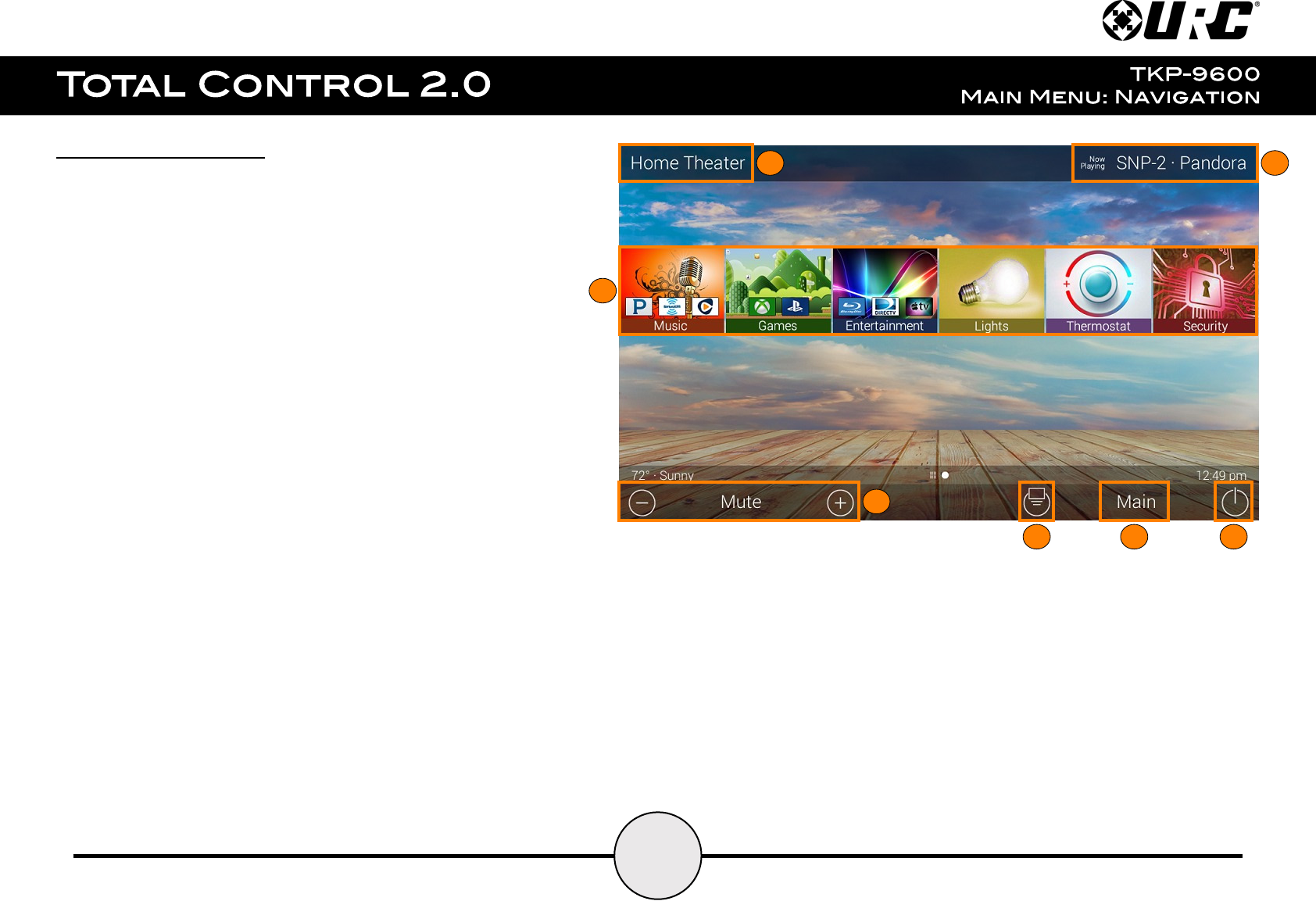
6
Main Menu Navigation:
Although specific screen design and certain options are dictated by the
custom integrator that programmed the Total Control 2.0 system, the general
layout remains the same.
Actual navigation is performed via screen swipes:
●Left Swipe: Swipe left to reveal additional Main Menu pages. The
amount of pages available on the Main Menu is dictated by the
custom integrator.
●Right Swipe: Swipe right to reveal the Scenes Menu. The Scenes
Menu contains URC Scenes that are created by the custom
integrator. Return to the Main Menu by swiping left from the
Scenes Menu.
●Button Tapping: On the Main Menu selecting each of these areas
provide the end-user with control:
1. Category/Device Ribbon: Select a Category button to reveal
the associated submenu OR select a Device located here to
access that devices menu. This is dictated by the
custom integrator.
2. Rooms Menu: Select the Room Name to access the
Room’s Menu. This menu allows the end-user to control another
room and more.
3. Volume Control: Tap the minus (Vol-) to lower the volume, plus
(Vol+) to increase the volume, and Mute to mute the volume.
4. Shortcuts: Select this button to reveal the Shortcuts Popup
menu. The end-user can add up to six (6) items on this menu.
5. Main: Select this to return to the Main Menu regardless of what page the device is
currently on. This can be changed to return to the Scenes Menu, speak with the custom
integrator to program the TKP-9600 this way.
6. Room Power Off: Select this button to turn off the current room.
7. Now Playing: Select the Now Playing button at the top to instantly jump into that
device/activity’s menu pages.
1
2
3
4
5
6
7
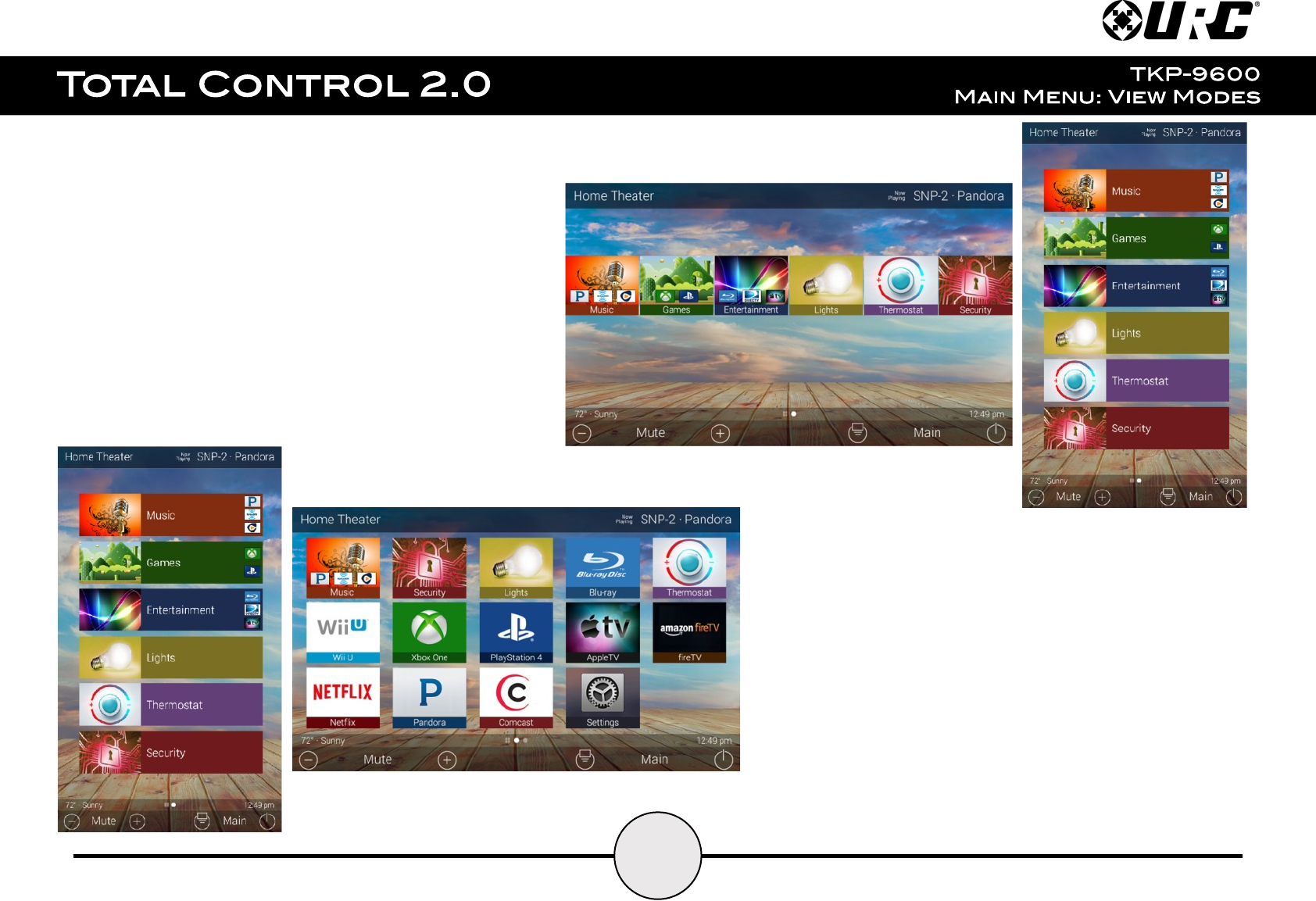
7
Main Menu: View Modes
Total Control 2.0 features two different view modes for the
TKP-9600. Each view mode has its own unique properties that
compliment the user experience.
The view mode must be programmed from within the
Accelerator 2.0 software, speak to a custom home integrator for
more details.
1. Ribbon View: This is the default view mode and it
contains up to six (6) items per page.
Ribbon View (Landscape & Portrait):
2. Grid View: This view mode contains up to
fifteen (15) items per page.
Grid View (Landscape & Portrait):
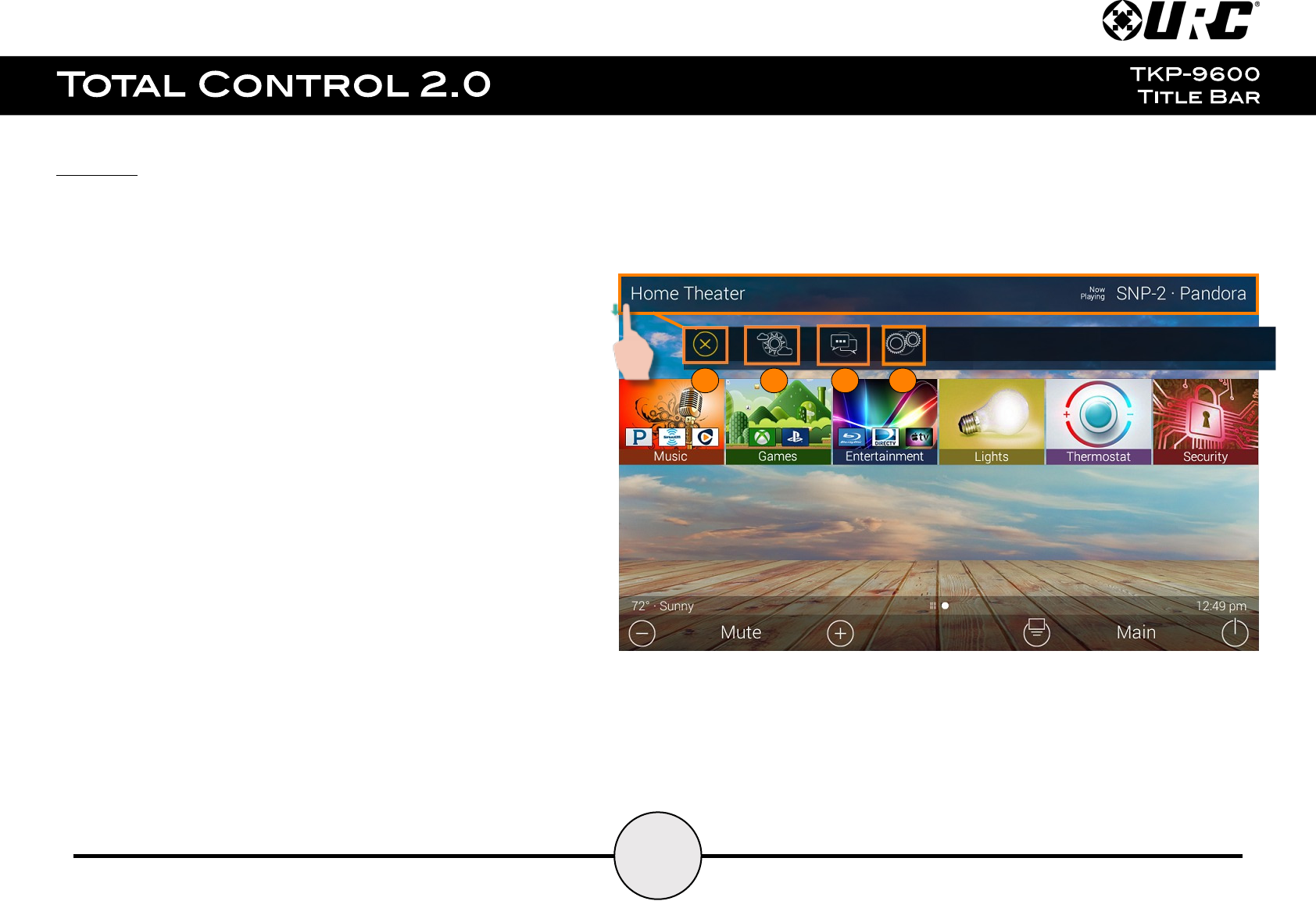
8
Title Bar:
The Title Bar is always present regardless of what menu and/or room the
TKP-9600 is currently using.
On the left of the Title Bar, the current room the TKP-9600 is controlling is
displayed. Selecting it reveals the Rooms Menu.
At the right of the Title Bar is the Now Playing area. This displays which
device/activity is currently active. Selecting it returns the interface to the
device/activity’s menu for control.
The Title Bar is located at the very top of the display. To access its menu,
swipe down as depicted on the image to the right. There are three (3)
selectable options here:
1. Close: Select this to hide the Title Bar Menu.
2. Weather Module: Select this to display the Time and Weather
Module, this feature requires the home location. This location is set
from within the Accelerator 2.0 software.
3. Intercom: Select this button to display the Intercom Menu. This
menu displays all available Intercom-Enabled device (clients). Please
see this documents Audio-Video Intercom section for more details.
4. Settings: Select this button to access the TKP-9600’s
Settings Menu. The various parts of the Settings Menu are
explained in detail in a later section of this document.
Current Room
Now Playing
1
2
3
4
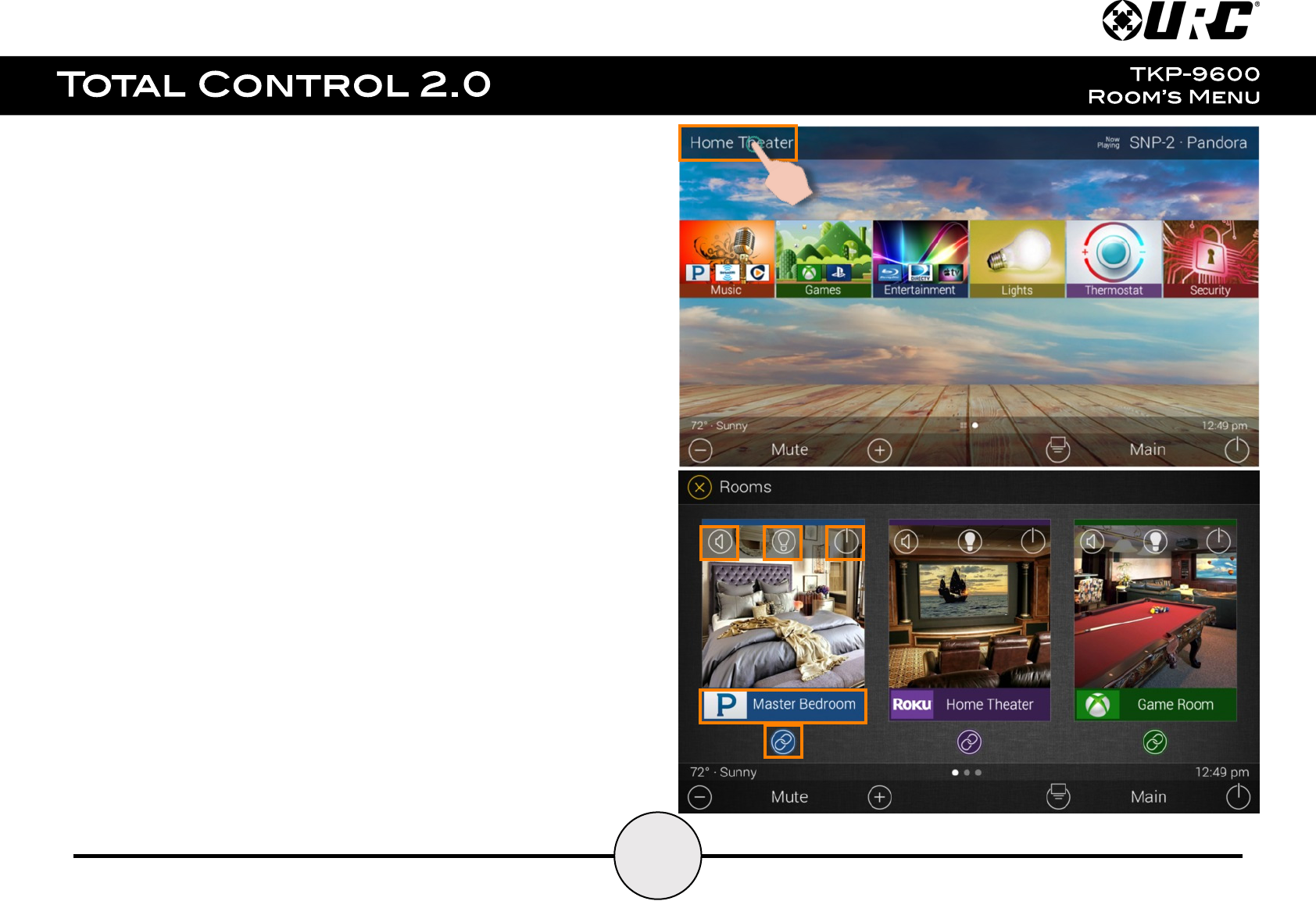
9
Room’s Menu:
Tap on the Room Name located on the left in the Title Bar to display the
Room’s Menu.
The Room’s Menu contains every room programmed into the system. Specific
rooms may be hidden from certain interfaces, speak to the custom home
integrator for that option.
Each room is given a Room Name and customized image to represent that
room. Additionally, the Room’s Menu can be used for controlling volume,
turning off the lights, or completely powering off a specific room.
Here are the selectable buttons in the Room’s Menu:
1. Volume Control: Select this button to reveal the Vol +, Vol -, and
Mute icons. This button is available on any room with audio sources.
2. Lights Off Action Command: This button is programmed by the
custom integrator and can be set to turn off all the lights in a
particular room.
3. Room Off: Select this button to turn off all the devices in that
particular room. This button can only be used to turn off a room.
4. Now Playing: This section displays what device/activity is currently
active in that room. Selecting this jumps the TKP-9600 to that
device/activity’s menu for control.
5. Room Linking: This feature is only available on DMS Audio device.
It is used to link DMS Zones/Areas. This means having one menu
that controls volume for multiple zones simultaneously or individually.
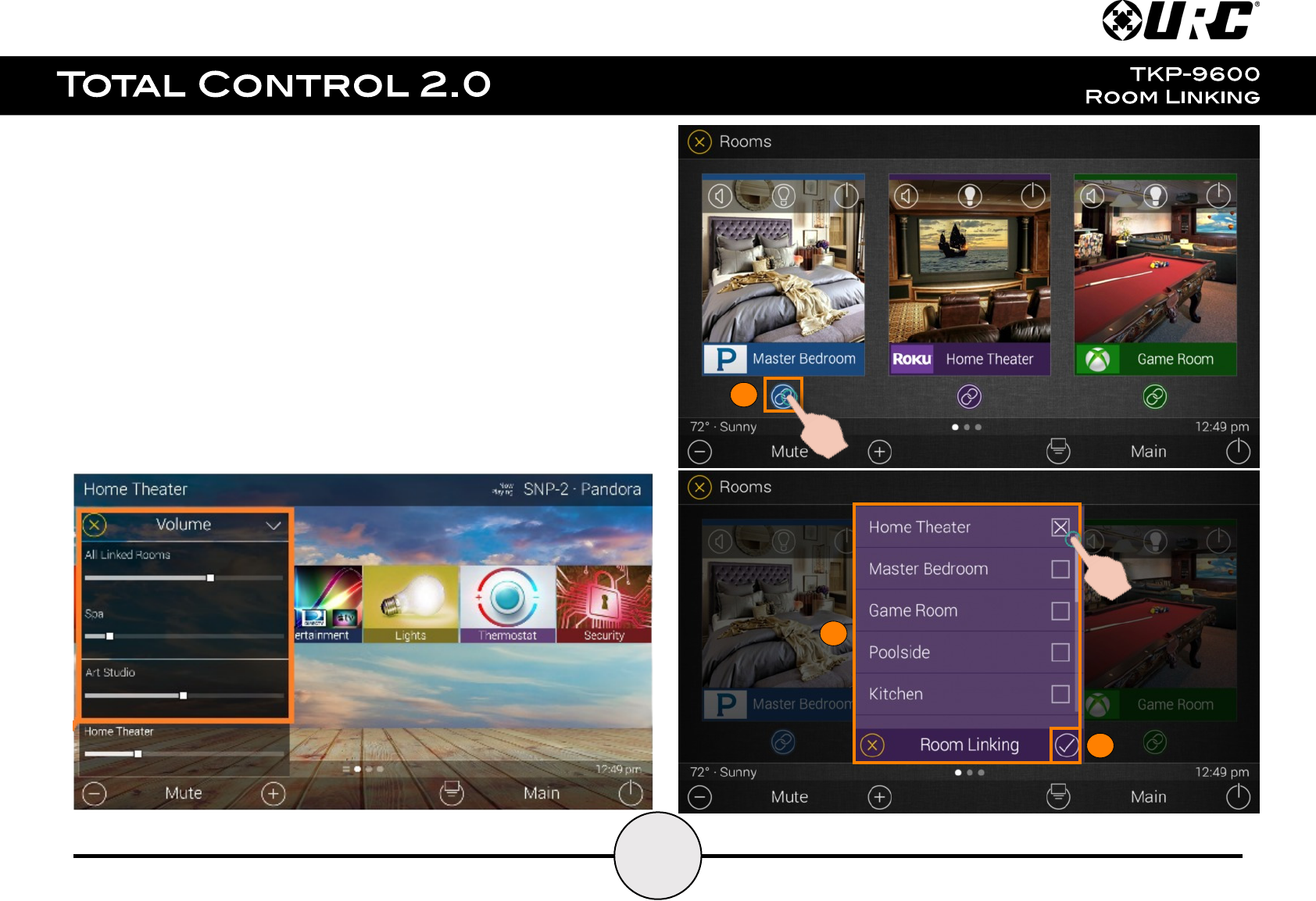
10
Room Linking:
Remember, Room Linking can only be used by DMS Zones/Areas. The
following steps take place from within the Room’s Menu:
1. Select the Room Link button, this displays the Room Linking Menu.
2. Select which rooms in the system to link. Only rooms that are
DMS Zones/Areas appear on the Room Linking Menu.
3. Select the Check to confirm.
These rooms are now linked. It is possible to control volume on all of
these rooms from one menu (see below). Control the volume of each
Linked Zone/Area individually or simultaneously using the
All Linked Rooms volume slider.
1
2
3
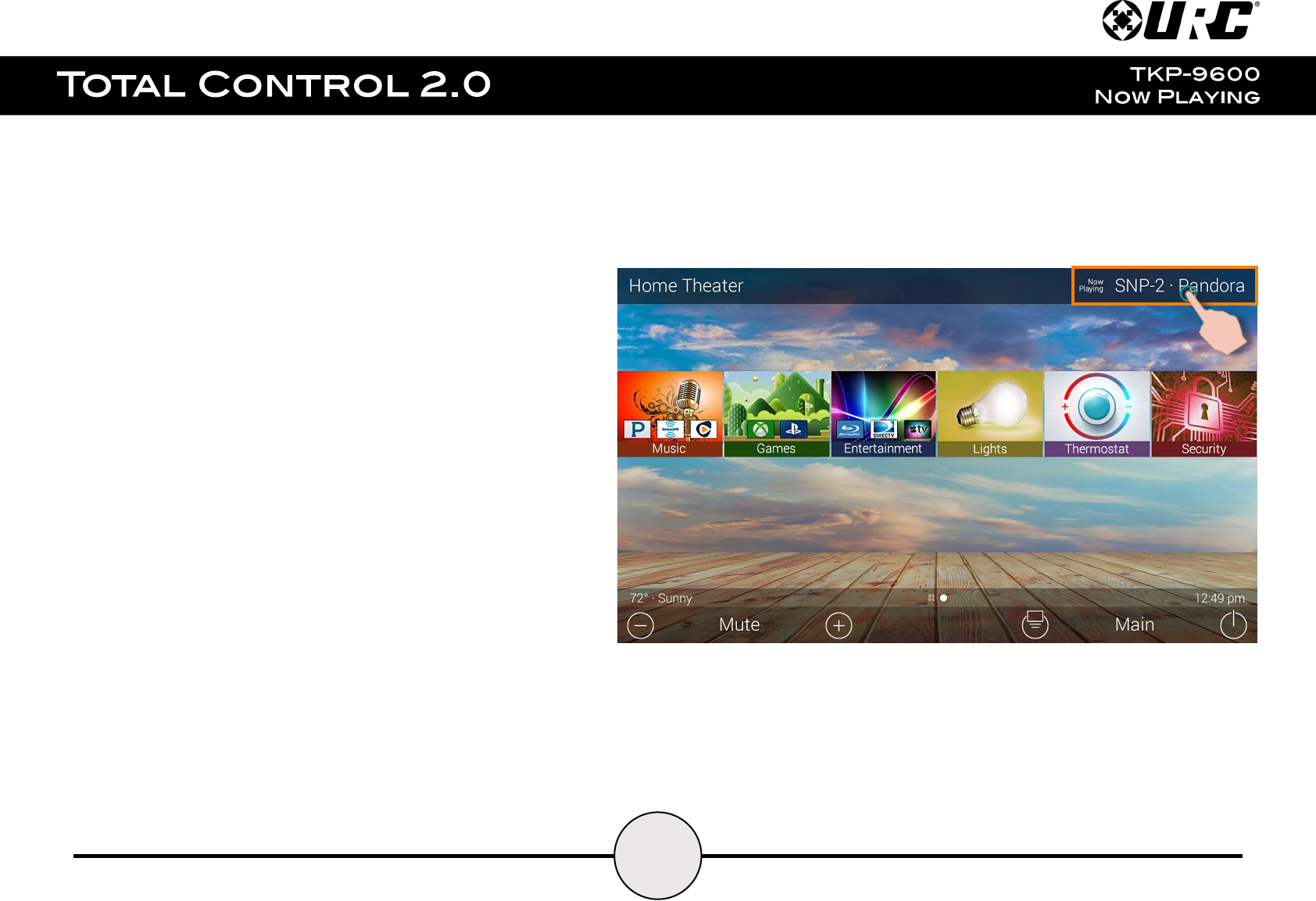
11
Now Playing:
On the right hand side of the Title Bar is the Now Playing area. The
Now Playing area always dictates what activity is currently playing in
the room.
In the example at the right, Now Playing reads “SNP-2 Pandora”.
This means that in the Home Theater the SNP-2 is using
Pandora currently.
Tapping the Now Playing area jumps the TKP-9600 to the menu for
the device in that section. In the example this mean that, once
tapped, the interface jumps to the SNP-2 device menu for control.
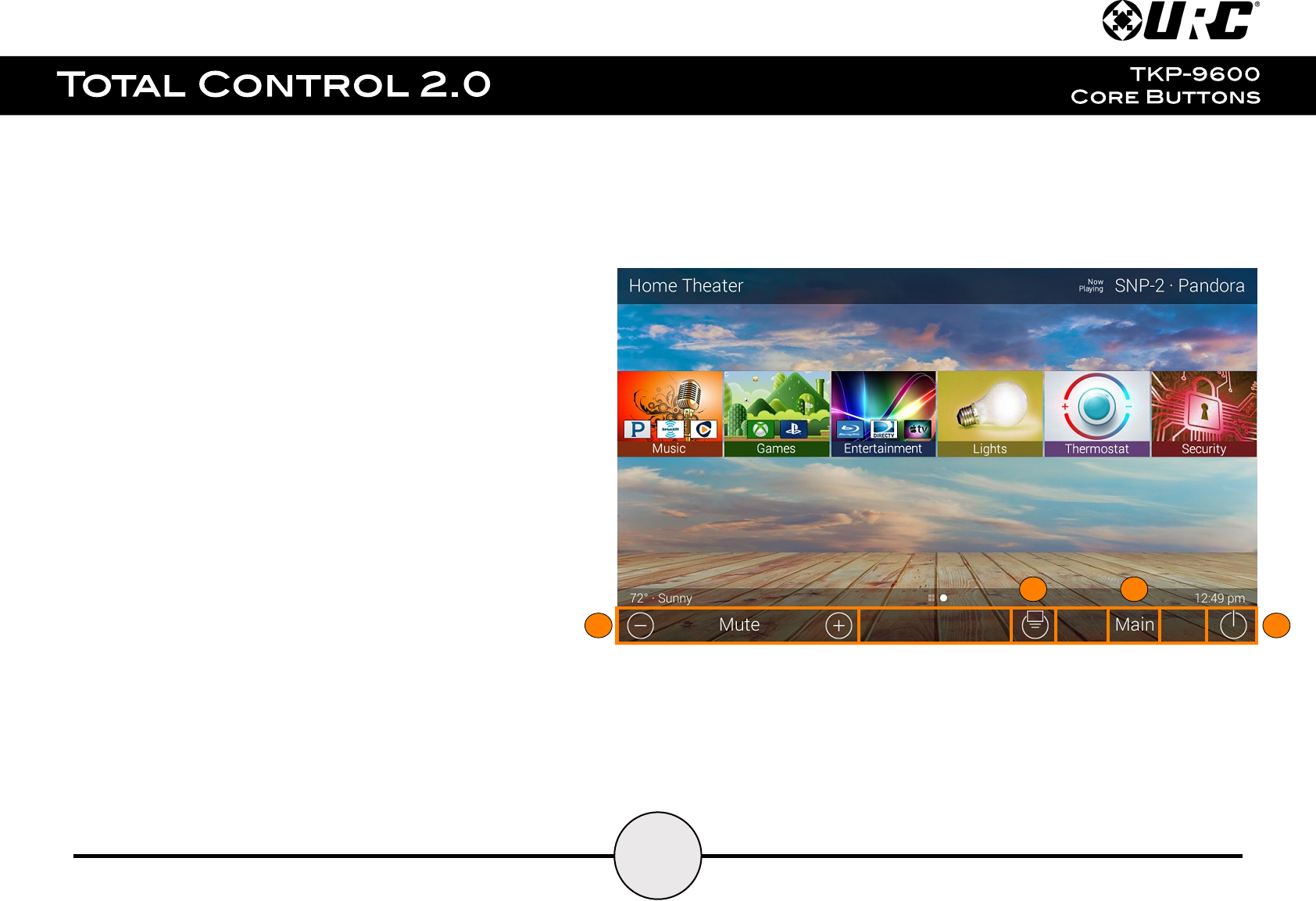
12
Core Buttons:
These buttons are almost always on display. Each one of these buttons has a
specific function:
1. Volume: Used to control an active audio device.
2. Shortcut Popup: Use this to display the Shortcut Popup Menu. This
menu contains up to six (6) current room activities.
3. Main: Select this to return to the Main Menu regardless of what
menu the interface is currently in use.
4. Room Off: Use this button to turn off the current room.
1
Vol-
Mute
Vol+
2
3
4
Shortcut Popup
Room Off
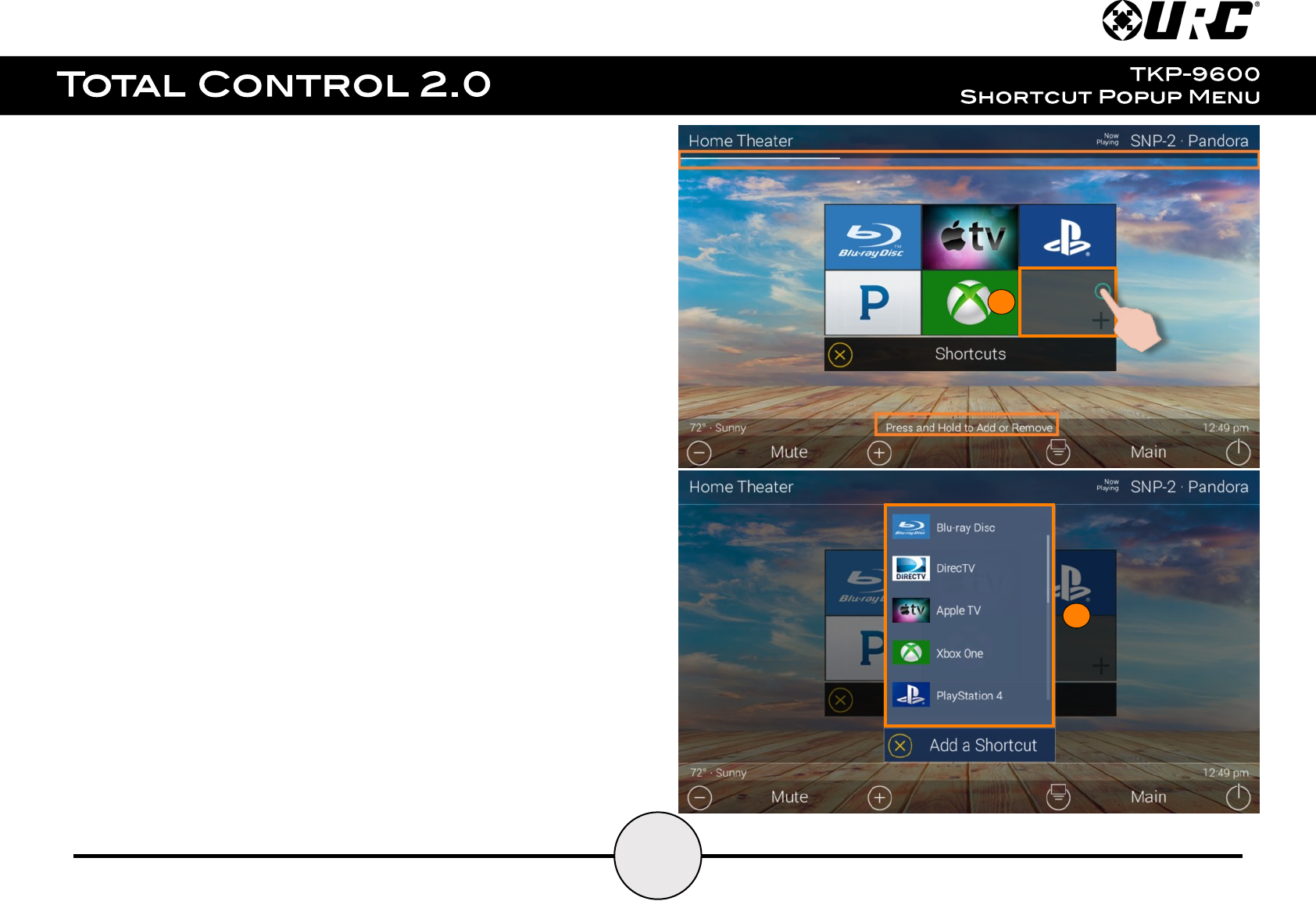
13
Shortcut Popup Menu:
The Shortcut Popup Menu can holds the end-user’s favorite or most
frequently used devices/activities and places them in one easy to
access location.
Adding Shortcuts:
Follow these steps to add a Shortcut:
1. Locate an available button and hold it down until the
status bar on the top of the display fills.
As stated on the bottom of the interface “Press and Hold
to Add or Remove”.
A list of device/activities for that room a presented in
the Add a Shortcut Menu.
2. Select a device/activity. This adds that item to the
Shortcut Popup Menu.
1
2
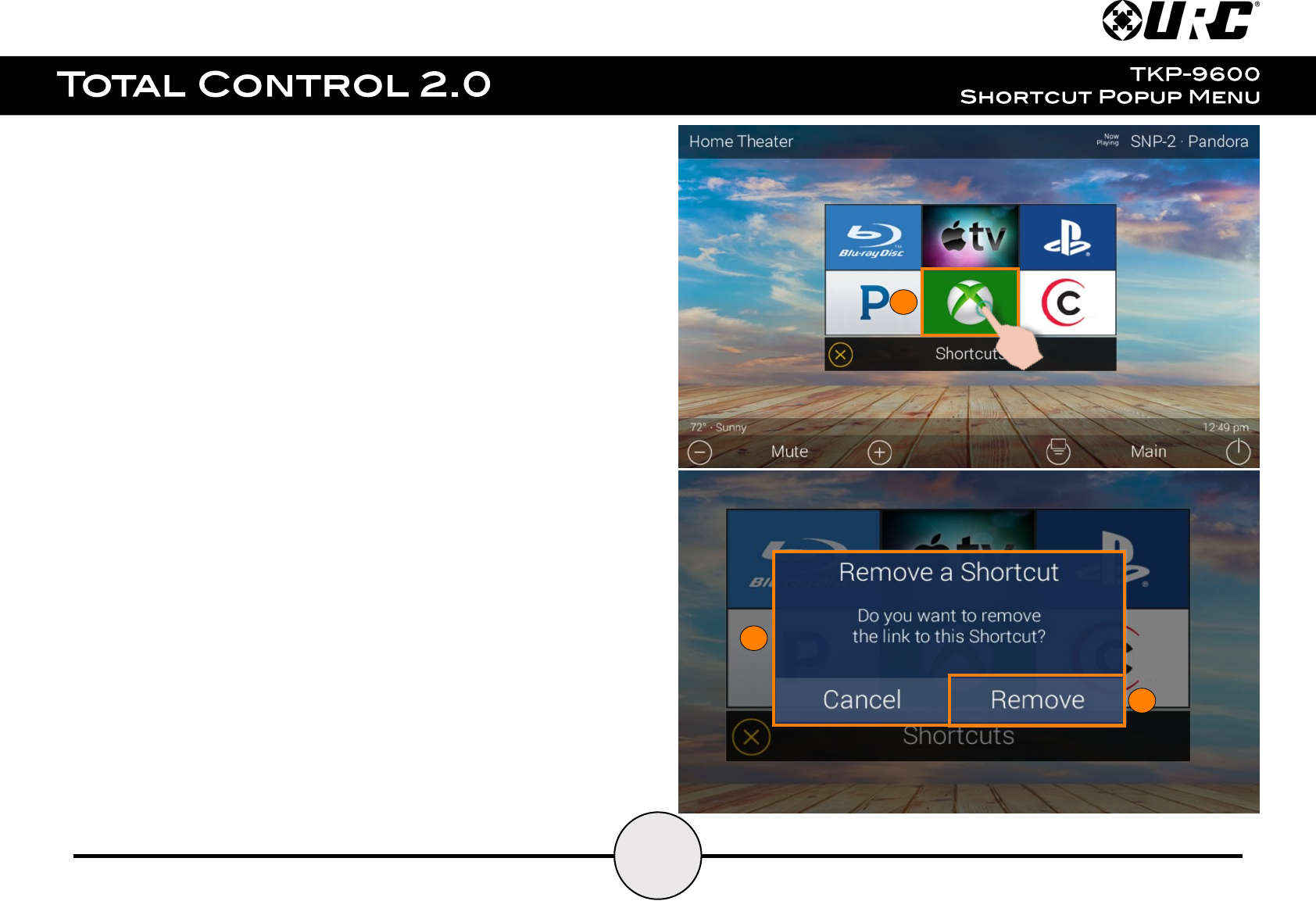
14
Just tap on a Shortcut button to launch that device/activity. Remember, this menu
can only hold up to six (6) items and each item must already be a device/activity
programmed into that current room.
Removing Shortcuts:
Follow these steps to remove a Shortcut:
1. From the Shortcut Popup Menu, press and hold the Shortcut that
needs to be deleted.
2. Hold the button until the Remote a Shortcut window displays.
3. Select Remove.
1
2
3
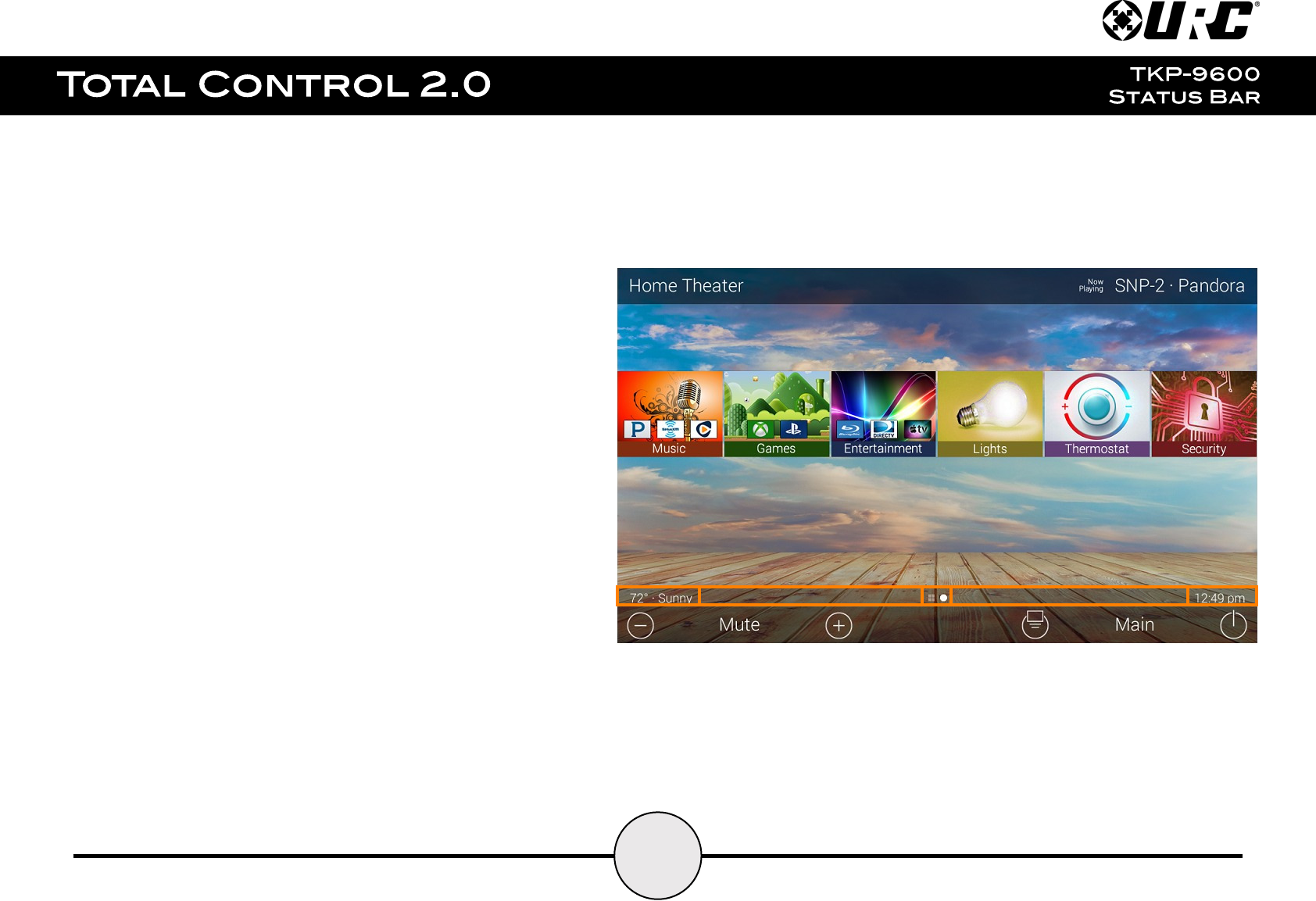
15
Status Bar:
Located above the Core Buttons, this section of the interface is almost always
on display. The Status Bar is designed to inform the end-user of various
different customizable options:
1. Metadata Information: Located to the far left, options selected from
the programming software cycle through here. Those selections are
the following:
●Room Linked Status: Whenever the chosen room/area is
“linked” to other rooms, it is acknowledged in this section.
●Room Alarm Clock Status: If the current room has an Alarm that
is set to activate, the status bar displays an alarm clock icon and
the next scheduled time/day.
●Vacation Mode Status: When Vacation Mode is activated, the
Status Bar displays “Vacation Mode On”. When inactive, the
Status Bar displays “Vacation Mode Off”.
●Sunrise: Updated at midnight every day, displays the sunrise time
for the next day.
●Sunset: Updated at midnight every day, displays the sunset time
for the next day.
●RSS Weather Alert: Based on the location entered by the system
programmer, the words “Weather Alert” appear if an automatic
alert is received via internet.
●DMS-AV Surround Mode Status: Displays the current sound
mode of the DMS-AV Surround Processor.
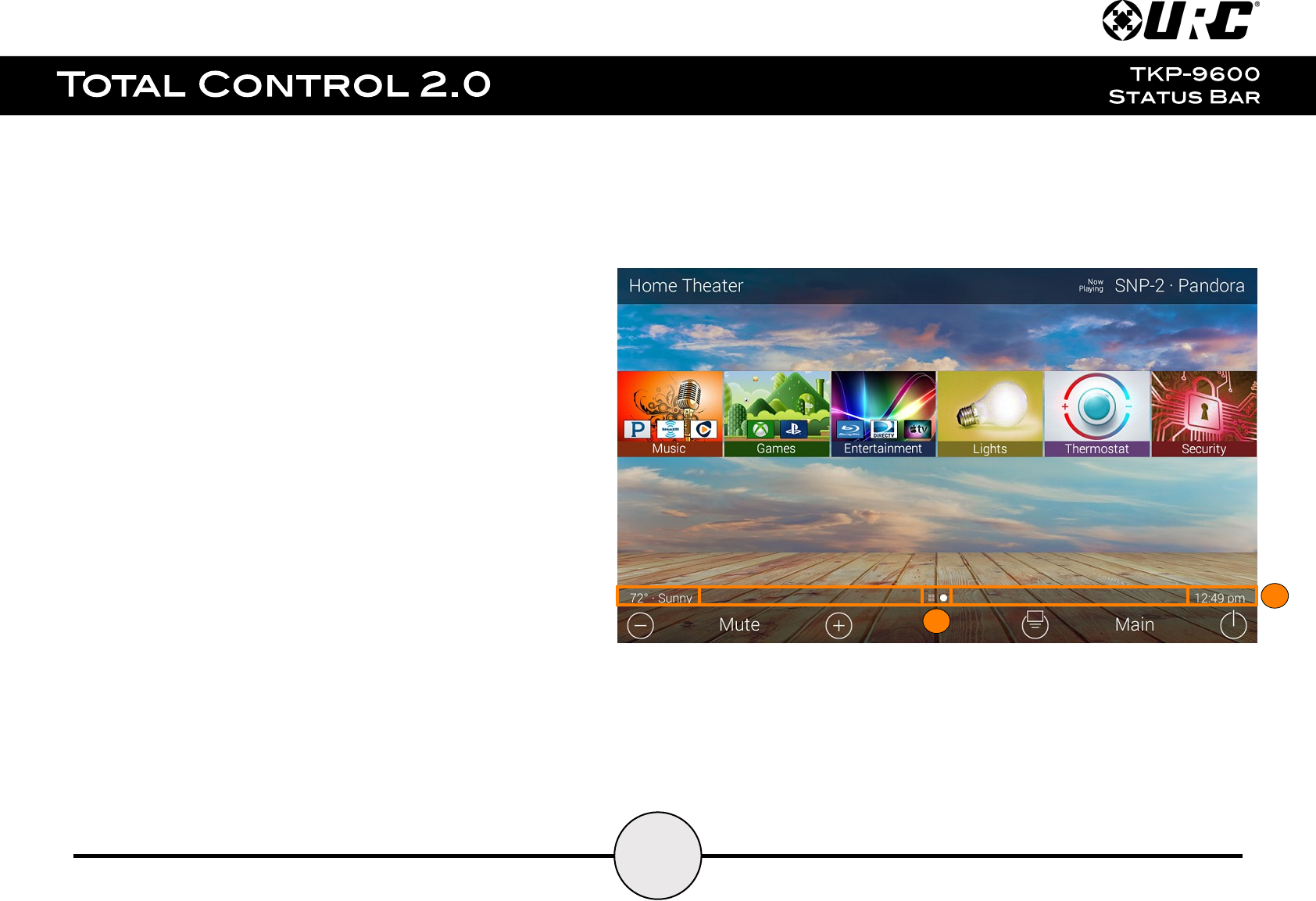
16
2. Page Indicator: The icons here represent the current page
number the interface is on. However, the icon located to the left
is the Scenes Menu icon. All icons to the right of that represent
page numbers.
3. Time: This is always present on the right hand side of the
interface. It serves as a quick and convenient place for the
end-user to check the time of day.
2
3
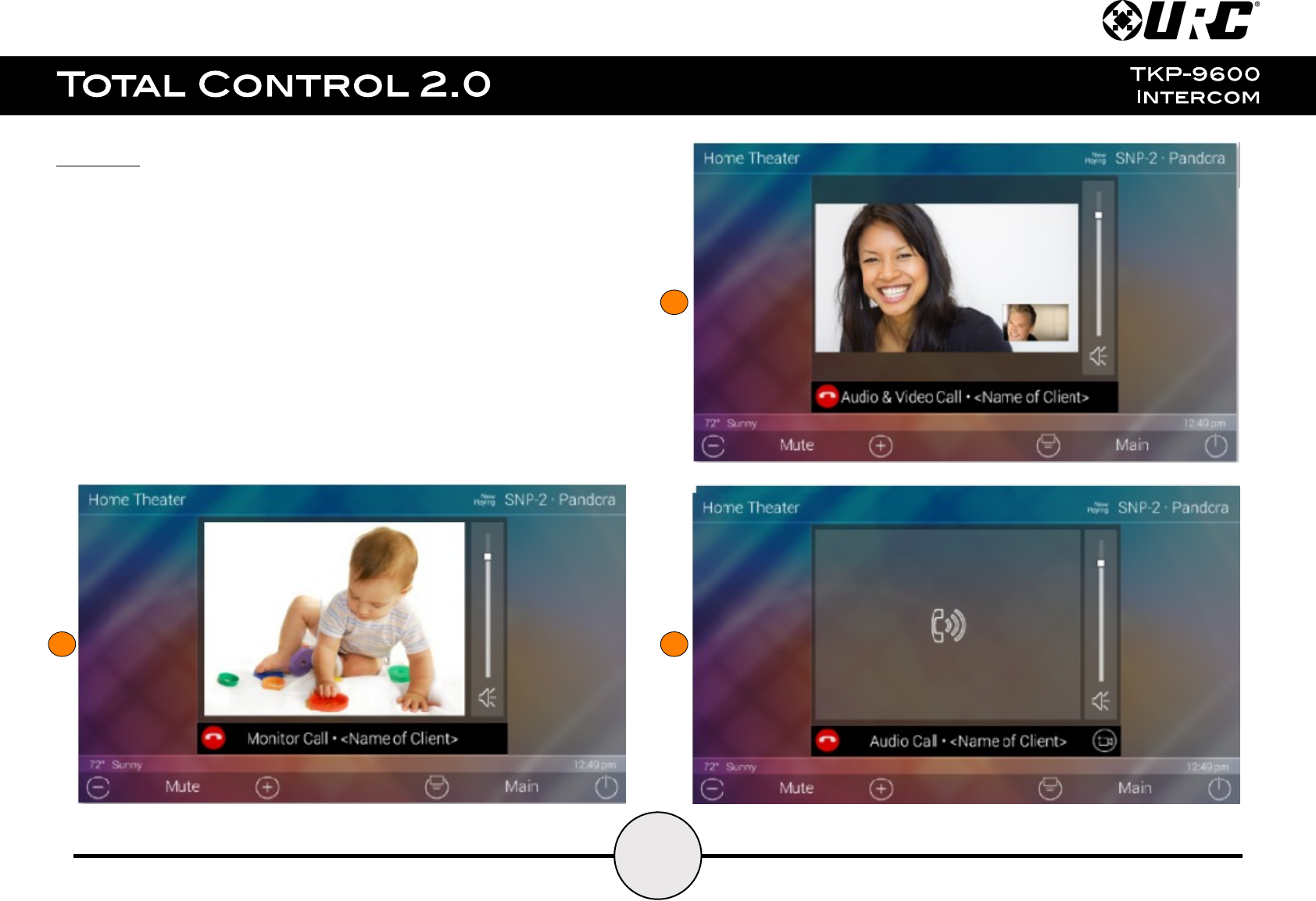
17
Intercom:
The TKP-9600 has the capability of communicating across the home network to any
Intercom-Enabled client (interface).
There are three (3) different types of intercom calls that can be made:
1. Audio-Video: This type of call uses the camera and microphone of the calling
and receiving client to provide auditory and visual feedback.
2. Audio Call: This type of call only uses the built in microphone of the calling
and receiving client to create an audio call over the home network.
3. Baby Monitor: This type of call uses the camera and microphone of only the
receiving client to provide auditory and visual feedback. These types of calls
allow one client to check the activity of another client in a different room.
1
2
3
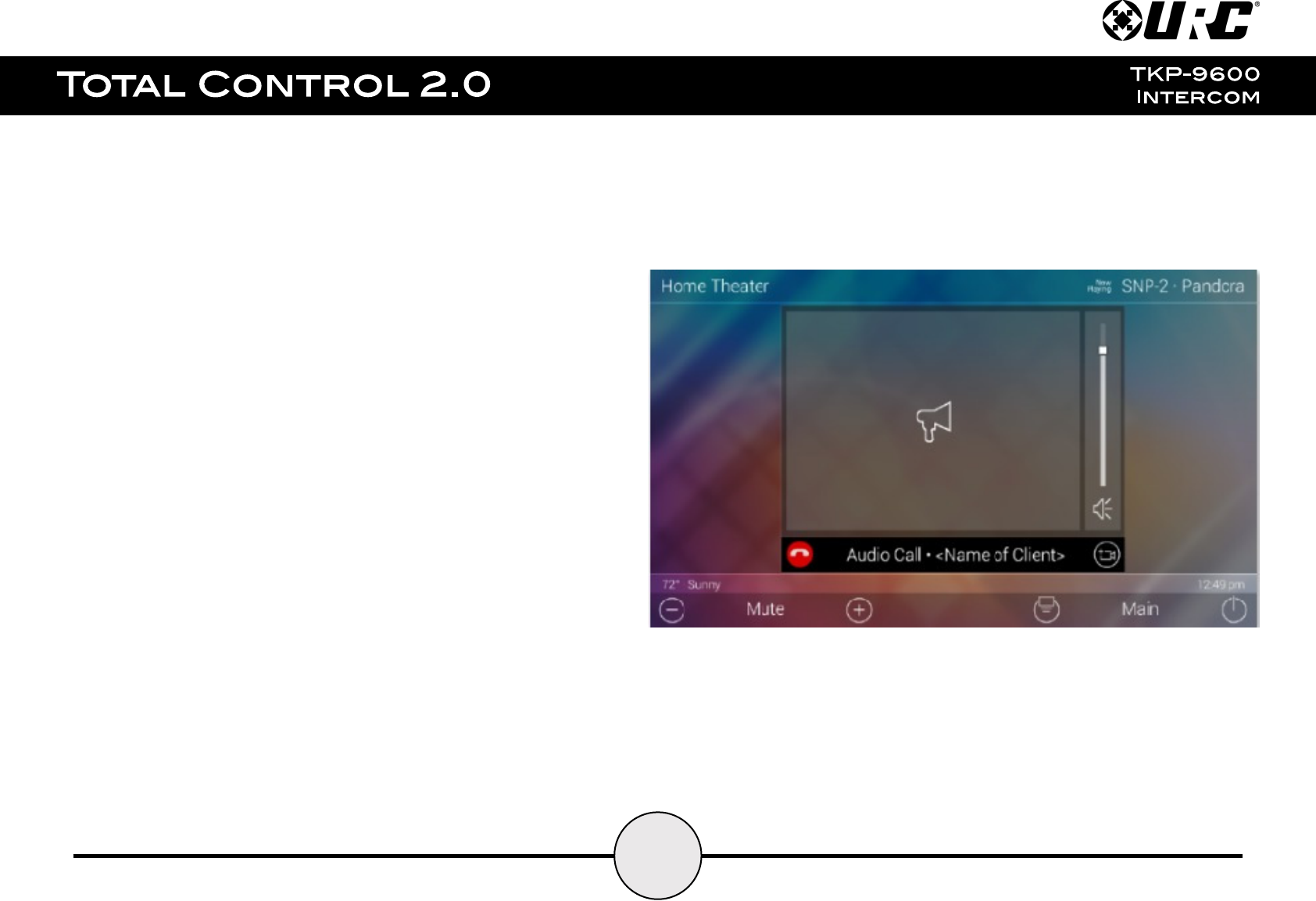
18
4. Audio Broadcast Call: This type of call is audio communication
between two or more clients. An ideal way to communicated across
multiple Intercom-Enabled interfaces in almost any home.
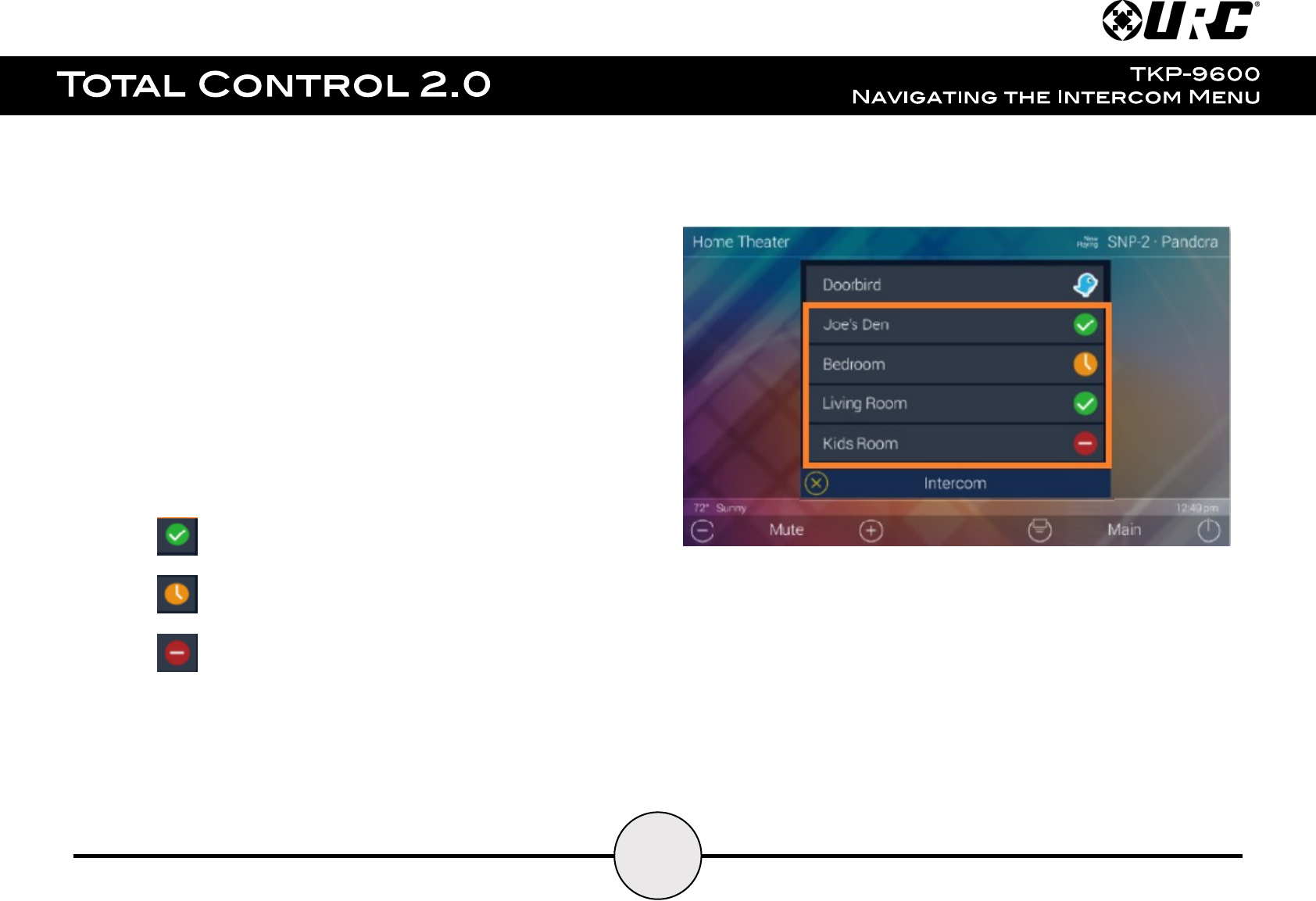
19
Navigating the Intercom Menu:
As mentioned on page 8 of this document, accessing the Intercom button is
performed by swiping down on the Title Bar.
After selecting the Intercom button from the Title Bar Menu, the Intercom Menu
displays. This menu presents the end-user with useful information:
1. Door Station Integration: In the case where a 3rd party door station has
been integrated with the Total Control 2.0 system, those device are located
at the top of the Intercom Menu.
2. System Clients: The Intercom Menu lists every Intercom-Enabled client in
the system. There are three (3) possible status modes for each client:
Available: The client is ready to receive any type of call.
Not Available/Busy: Signifies the client is unable to receive a call.
Do Not Disturb: Signifies the client is currently in Do Not Disturb mode.
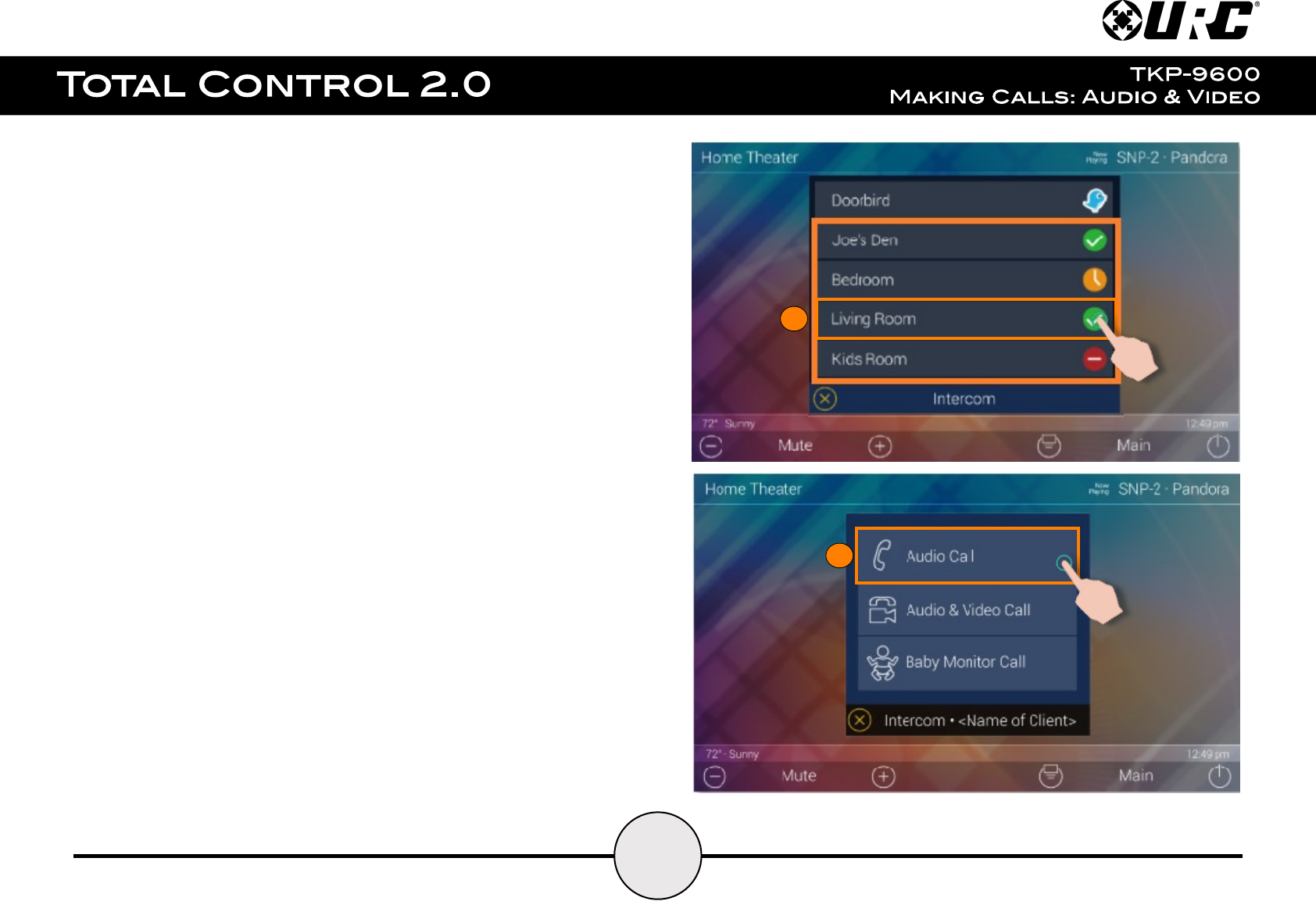
20
Making Calls: Audio-Video
Remember that the Intercom feature must be enabled from with in the Settings
Menu. The following steps take place from the Intercom Menu, to access this menu
refer to page 8:
1. Select an available client from the Intercom Menu.
After selecting a client, the three (3) call options are displayed. This is almost
always displayed after selecting an available client.
2. Select Audio & Video Call.
1
2
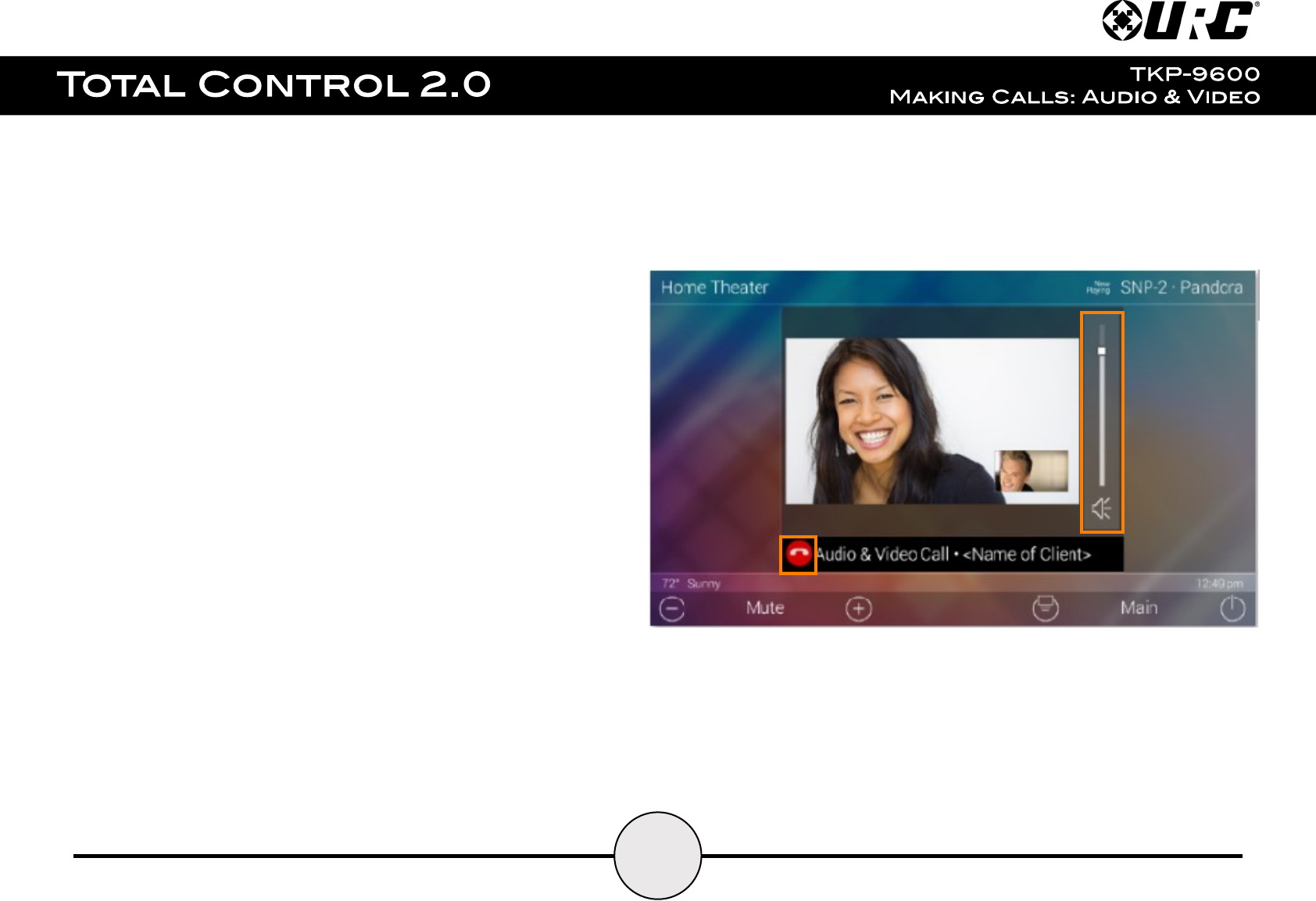
21
Once the call is accepted, the TKP-9600 provides auditory and visual two-way
feedback on the screen.
Use the Volume Slider at the right of the video feedback to raise or slower the
volume. Slide the indicator to the top for maximum volume or slide it down to the
bottom to mute the audio.
To end an Audio & Video call, select the End Call button (see image at right).
This immediately ends the call and returns the TKP-9600 to the Intercom Menu.
Volume Slider
End Call
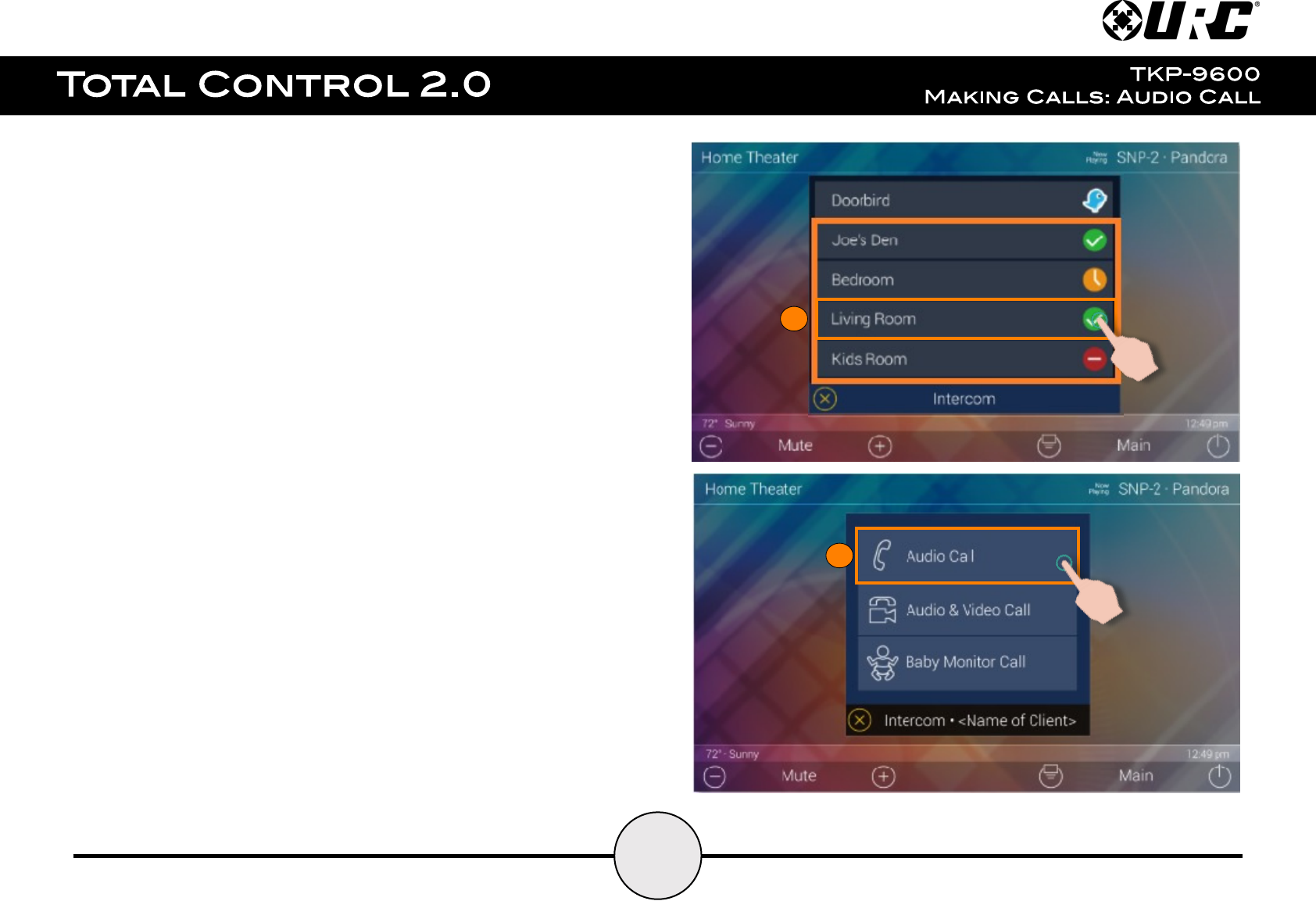
22
1
2
Making Calls: Audio Calls
Remember that the Intercom feature must be enabled from with in the
Settings Menu. The following steps take place from the Intercom Menu, to
access this menu refer to page 8:
1. Select an available client from the Intercom Menu.
After selecting a client, the three (3) call options are displayed. This is
almost always displayed after selecting an available client.
2. Select Audio Call.
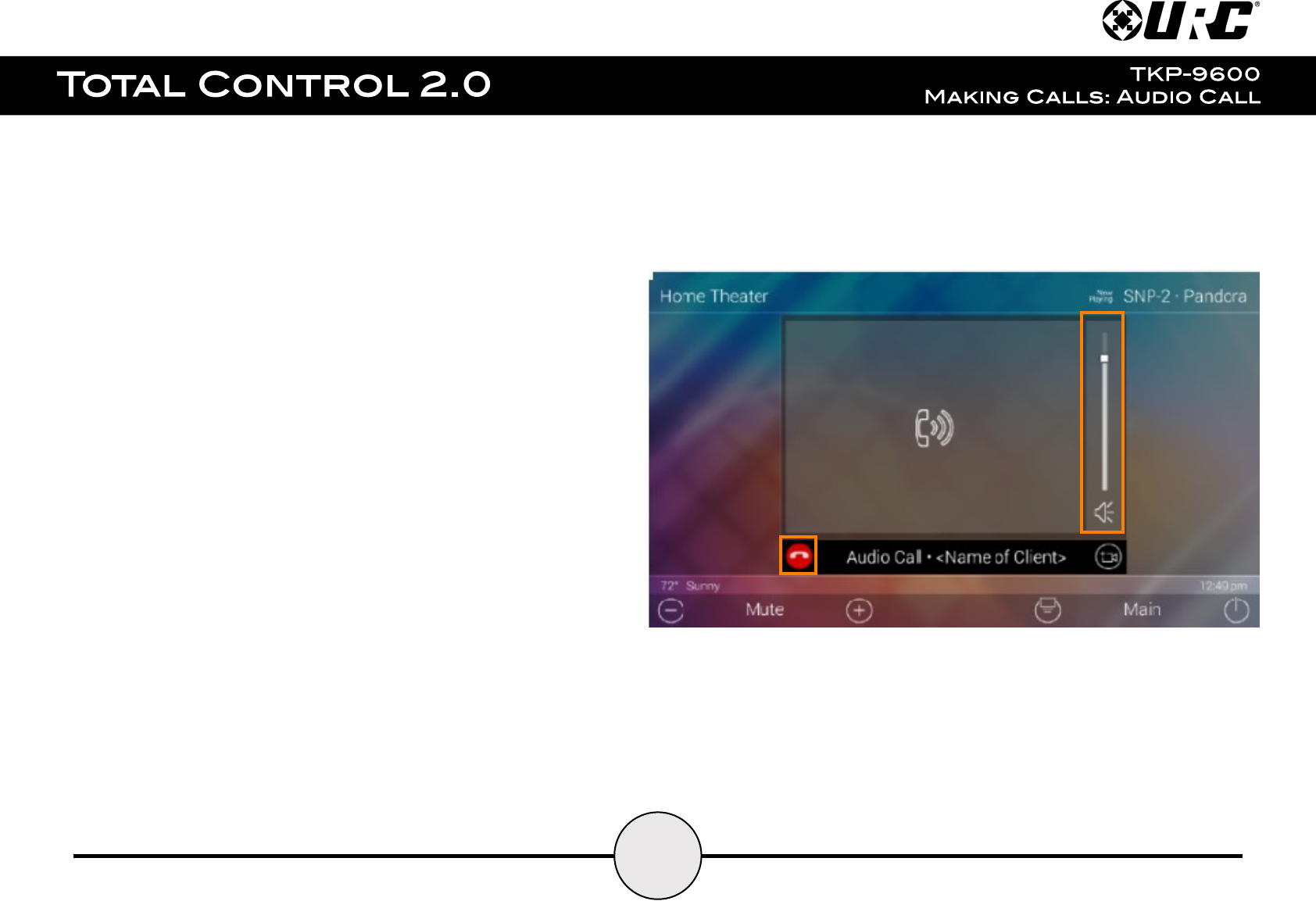
23
Once the call is accepted, the TKP-9600 provides two-way communication
between clients via audio only.
Use the Volume Slider at the right of the call icon area to raise or slower the
volume. Slide the indicator to the top for maximum volume or slide it down to the
bottom to mute the audio.
To end an Audio Call, select the End Call button (see image at right). This
immediately ends the call and returns the TKP-9600 to the Intercom Menu.
Volume Slider
End Call
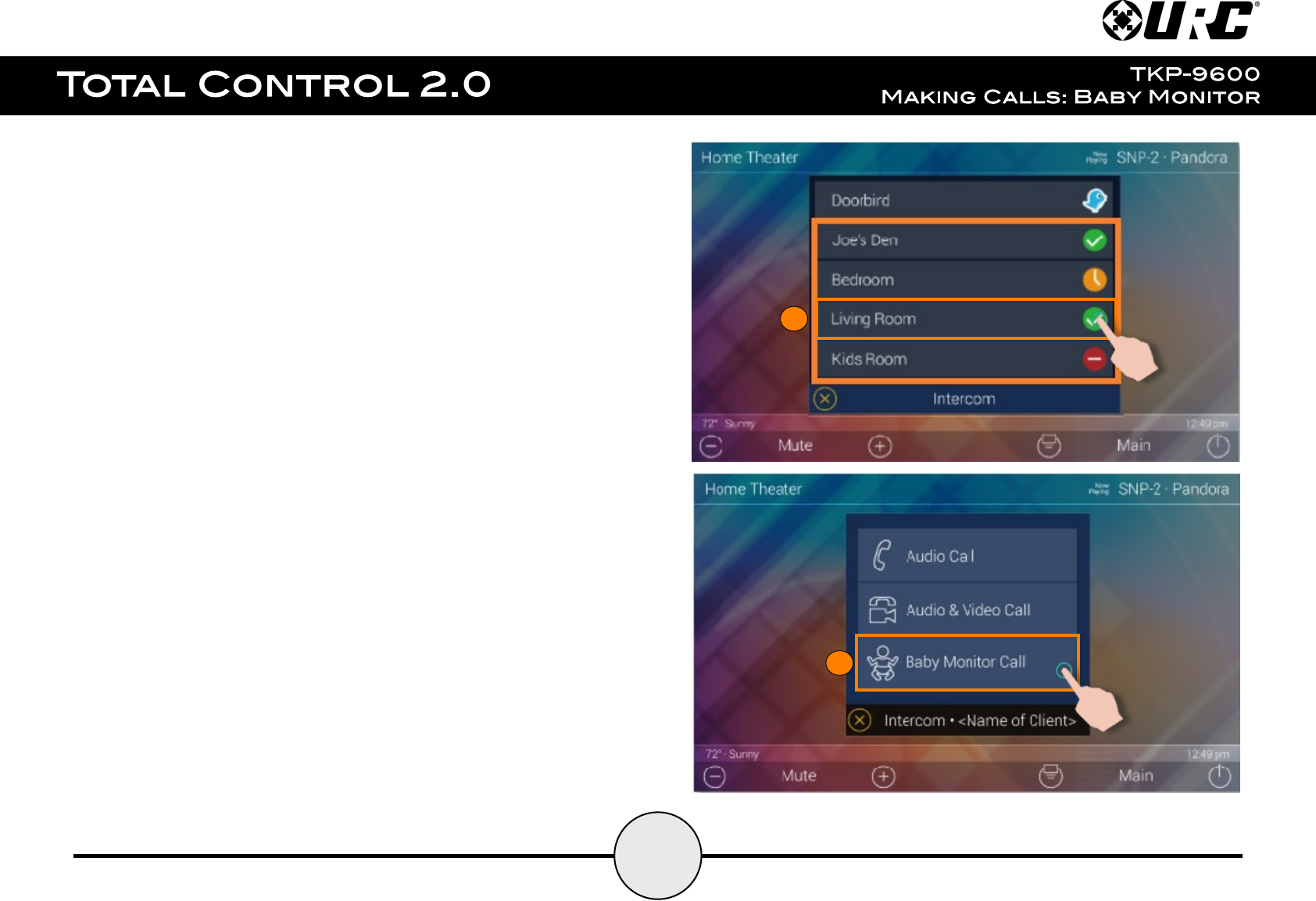
24
1
2
Making Calls: Baby Monitor
Remember that the Intercom feature must be enabled from with in the Settings
Menu. The following steps take place from the Intercom Menu, to access this
menu refer to page 8:
1. Select an available client from the Intercom Menu.
After selecting a client, the three (3) call options are displayed. This is
almost always displayed after selecting an available client.
2. Select Baby Monitor Call.
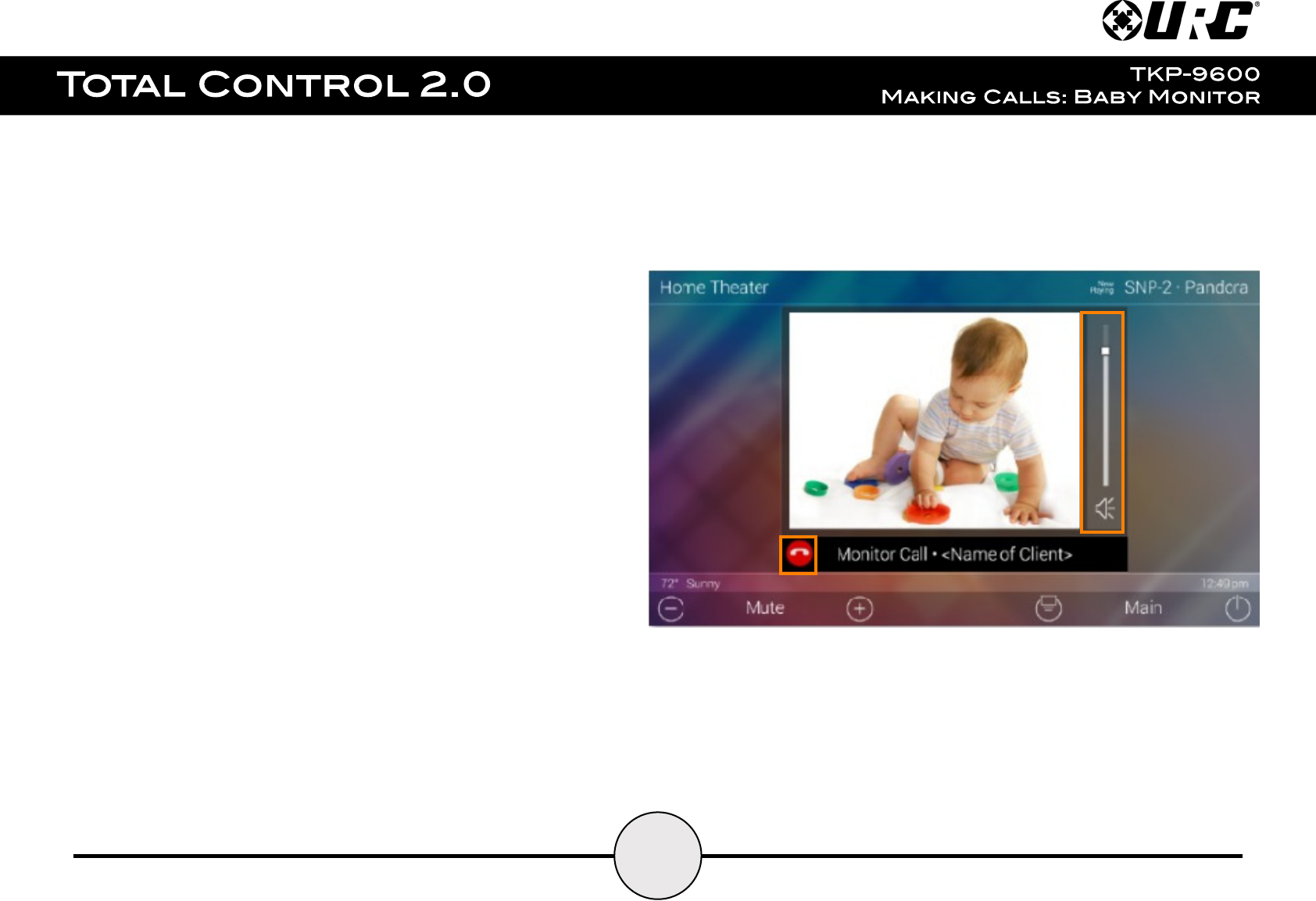
25
When using a Baby Monitor Call, the receiving client is not notified. It provides
one-way communication from the receiving client to the calling client.
Use the Volume Slider at the right of the video feedback to raise or slower the
volume. Slide the indicator to the top for maximum volume or slide it down to the
bottom to mute the audio.
To end an Audio & Video call, select the End Call button (see image at right).
This immediately ends the call and returns the TKP-9600 to the Intercom Menu.
Volume Slider
End Call
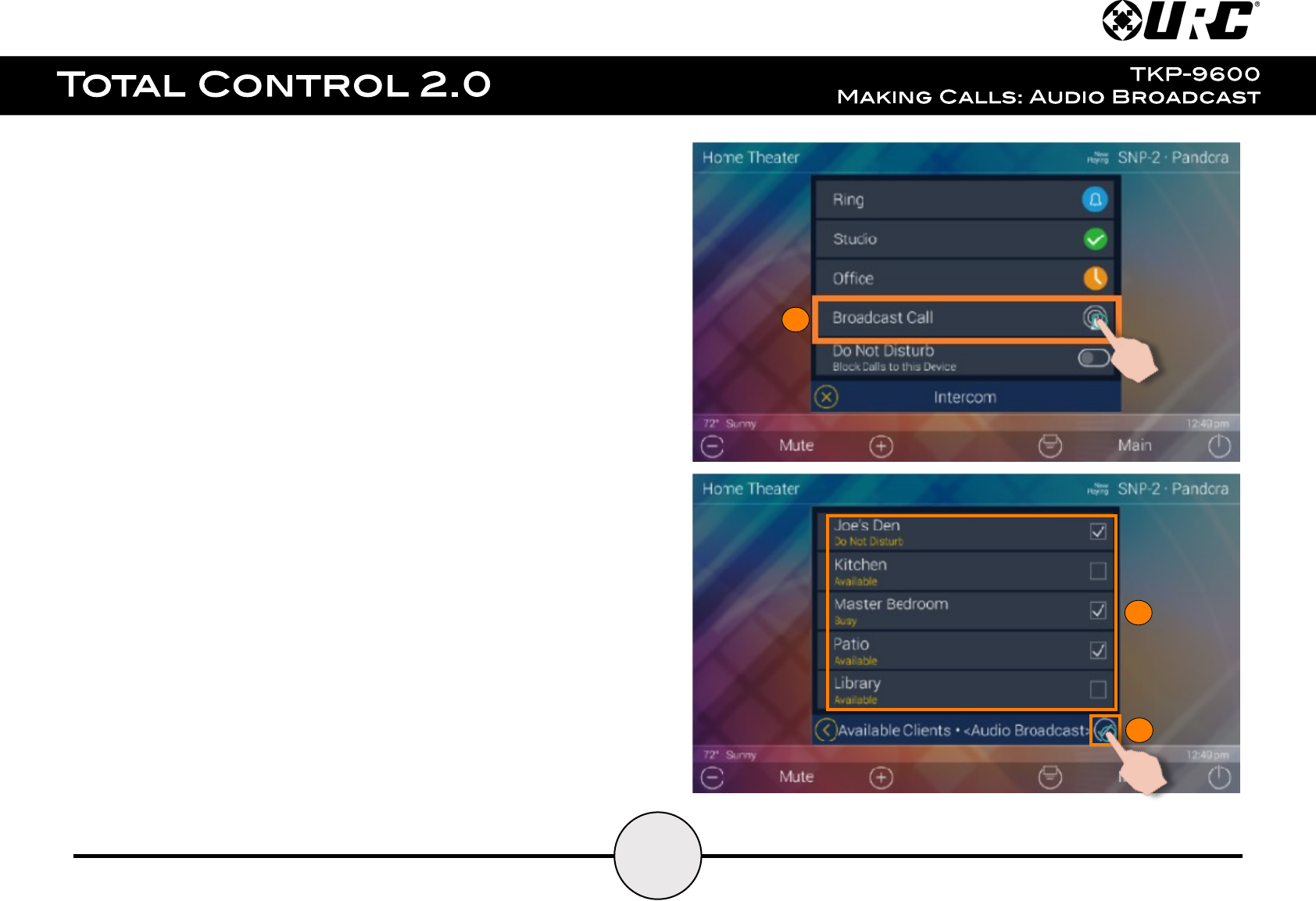
26
Making Calls: Audio Broadcast
Remember that the Intercom feature must be enabled from with in the Settings
Menu. The following steps take place from the Intercom Menu, to access this
menu refer to page 8:
1. Select Broadcast Call. A list populates of all available
Intercom-Enabled devices.
2. Check the boxes of the clients to include in the Audio Broadcast.
3. Select the Confirmation button.
1
2
3
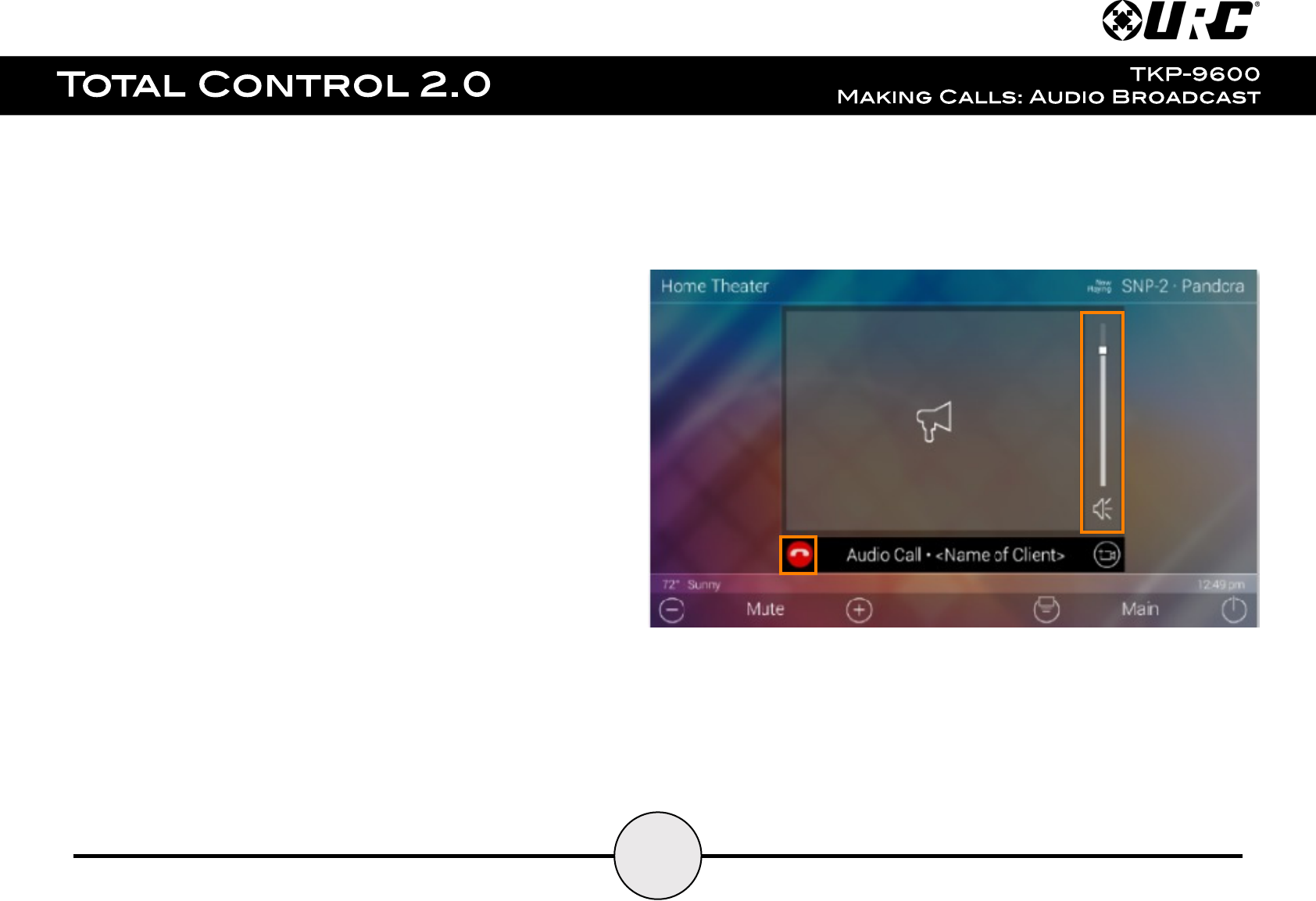
27
Once the call is established, all selected devices communicate via audio.
Use the Volume Slider at the right of the call icon area to raise or slower the
volume. Slide the indicator to the top for maximum volume or slide it down to the
bottom to mute the audio.
To end an Audio Call, select the End Call button (see image at right). This
immediately ends the call and returns the TKP-9600 to the Intercom Menu.
Volume Slider
End Call
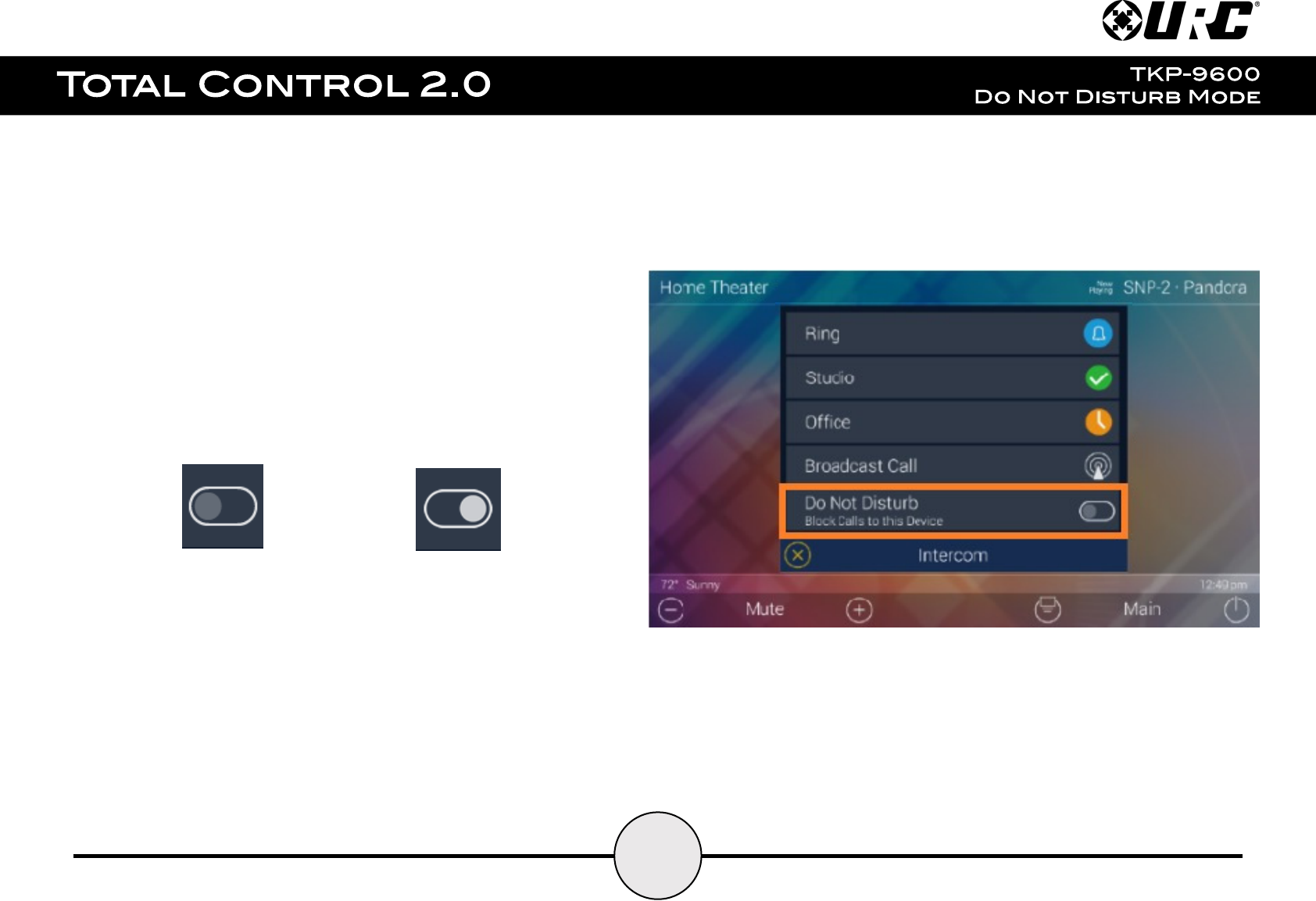
28
Do Not Disturb Mode:
Enabling the Do Not Disturb feature sets the current TKP-9600 unavailable.
This means that the keypad cannot receive any calls from other interfaces.
To enable this feature, use the slider located at the right of the text
Do Not Disturb. These are the possible states:
Do Not Disturb: ON
Do Not Disturb: OFF
This button functions as a toggle. Select it once to enable and tap the slider
again to disable Do Not Disturb Mode.
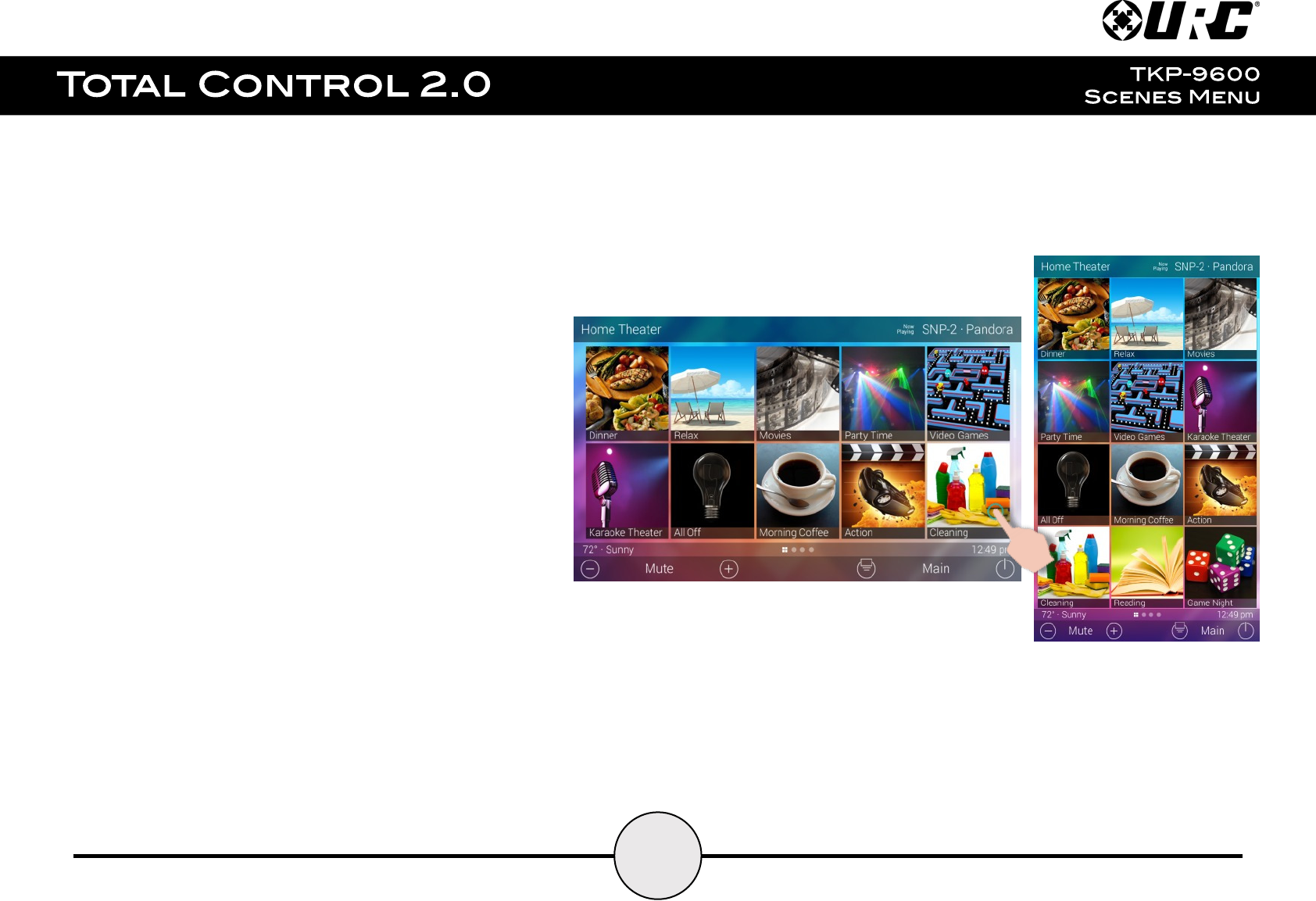
29
Scenes Menu:
The Scenes Menu is dictated by the system programmer. Access this menu
by swiping to the right from the Main Menu.
The Scenes Menu can contain up to a hundred (100) Scenes (buttons) per
room. Keep in mind that the Scene Menu is unique to each room.
Tap any button on the Scenes Menu to select a particular activity.
Additionally the Scenes Menu can be set as the landing page when the
Main button is selected.
Scenes can trigger any individual device or multiple devices to perform a
particular activity. For example, selecting a Scene like Cleaning (see right),
can turn off the television and turn on a music source.
Since each Scene must be programmer through the Accelerator 2.0
software, be sure to speak with a custom home integrator for Scene idea
and/or requests.
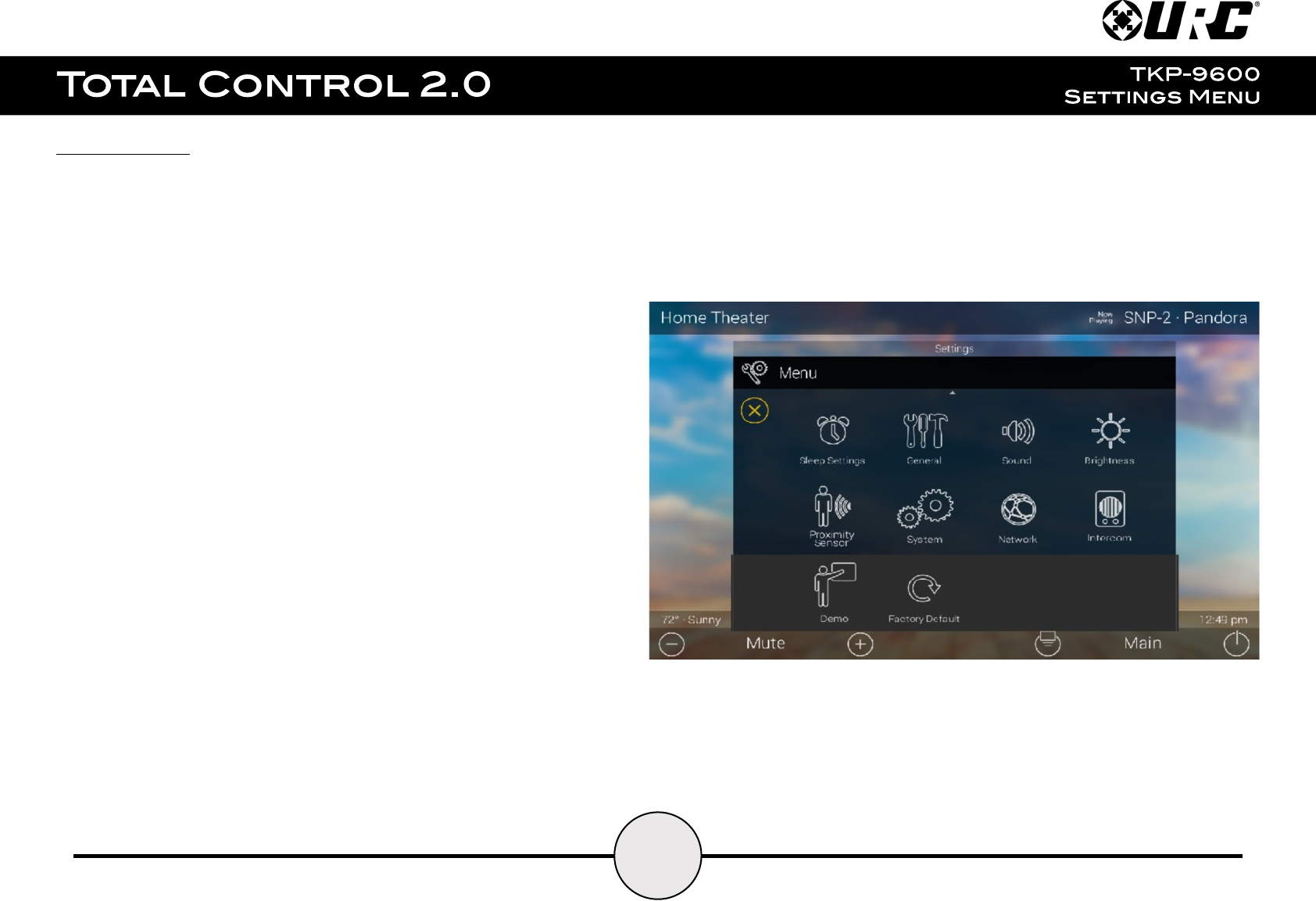
30
Settings Menu:
Access the Settings Menu by sliding the Title Bar and selecting the Settings
button, refer to page 8 for more details.
Most settings do NOT require interaction with the end-user. Changing some
settings could cause issues with the Total Control 2.0 system, only do so when
instructed by URC Technical Support.
These are the available options:
●Sleep Settings: Manage when the LCD screen turns OFF.
●General: Contains all the general settings for the TKP-9600. Allows
from the adjustment of Date, Time, and Temperature Scale.
●Sound: Adjust the volume of the audio feedback when pressing buttons
on the interface.
●Brightness: Allows for the adjustment of the LCD screen’s brightness.
●Proximity Sensor: Allows for the adjustment of the proximity level.
●System: Provides general information such as memory used, current
version, and version details.
●Network: Allows for the setting of a Dynamic or Static IP address for
the TKP-9600 and also gives general info about the network.
●Intercom: This is used to set up the Intercom of the TKP-9600.
●Demo: Used to create a simulation system that the TKP-9600 can use
to show off interface features.
●Factory Reset: Allows the TKP-9600 to be reset to its factory state.
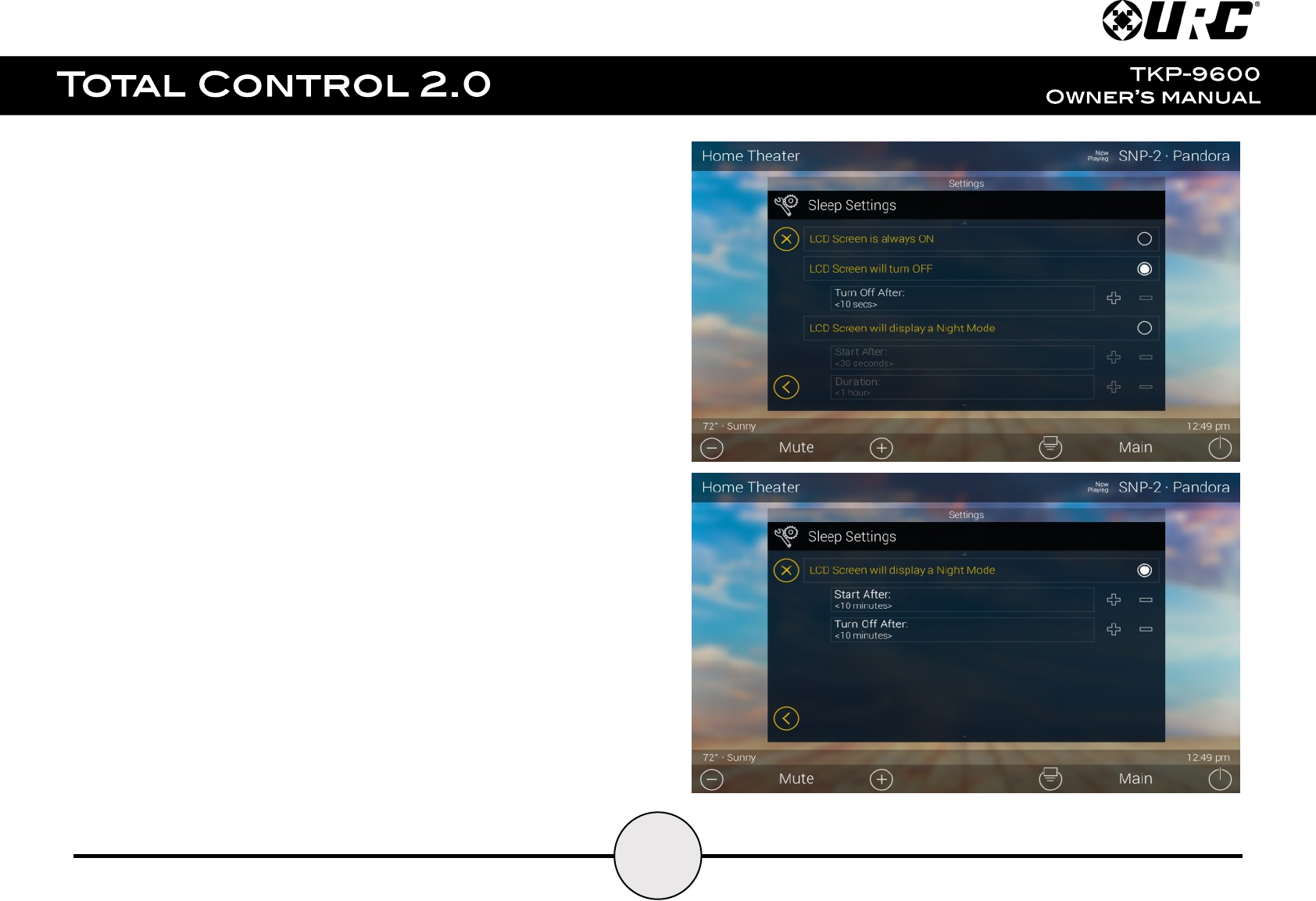
31
Sleep Settings:
Below are the selectable choices available in this menu:
1. LCD Screen is Always On: When selected, the TKP-9600’s display
never turns off.
2. LCD Screen will Turn Off: When selected the Turn Off After section is
selectable. Choose from a 20 second, 30 second, or one (1) minute
time out.
3. LCD Screen will Display a Night Mode: When selected the Start After
and Duration option become active.
●Start After: The TKP-9600 times out based on the value entered here
and goes into Night Mode.
●Turn Off After: The TKP-9600 turns off Night Mode after the value
entered here.
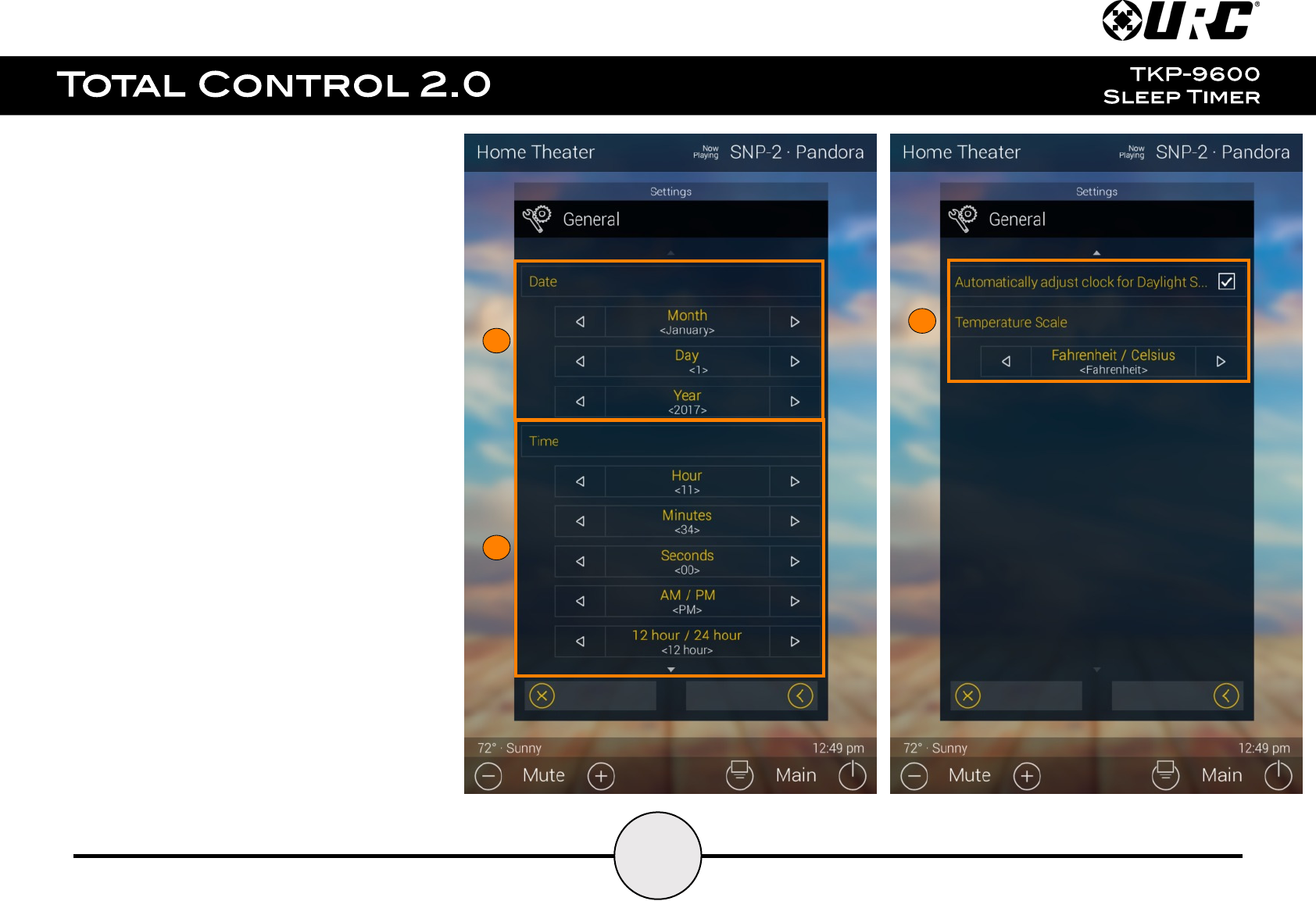
32
General:
Using the left and right arrow keys, enter the values of
each category:
1. Date: The following can have its
value changed:
●Month
●Day
●Year
2. Time: The following can have its
value changed:
●Hour
●Minutes
●Seconds
●AM/PM
●12 Hour/24 Hour
3. Automatically Adjust Clock for Daylight
Savings: Check this box to have the TKP-9600
automatically adjust for daylight savings.
4. Temperature Scale: Set this either to
Fahrenheit or Celsius.
1
2
3
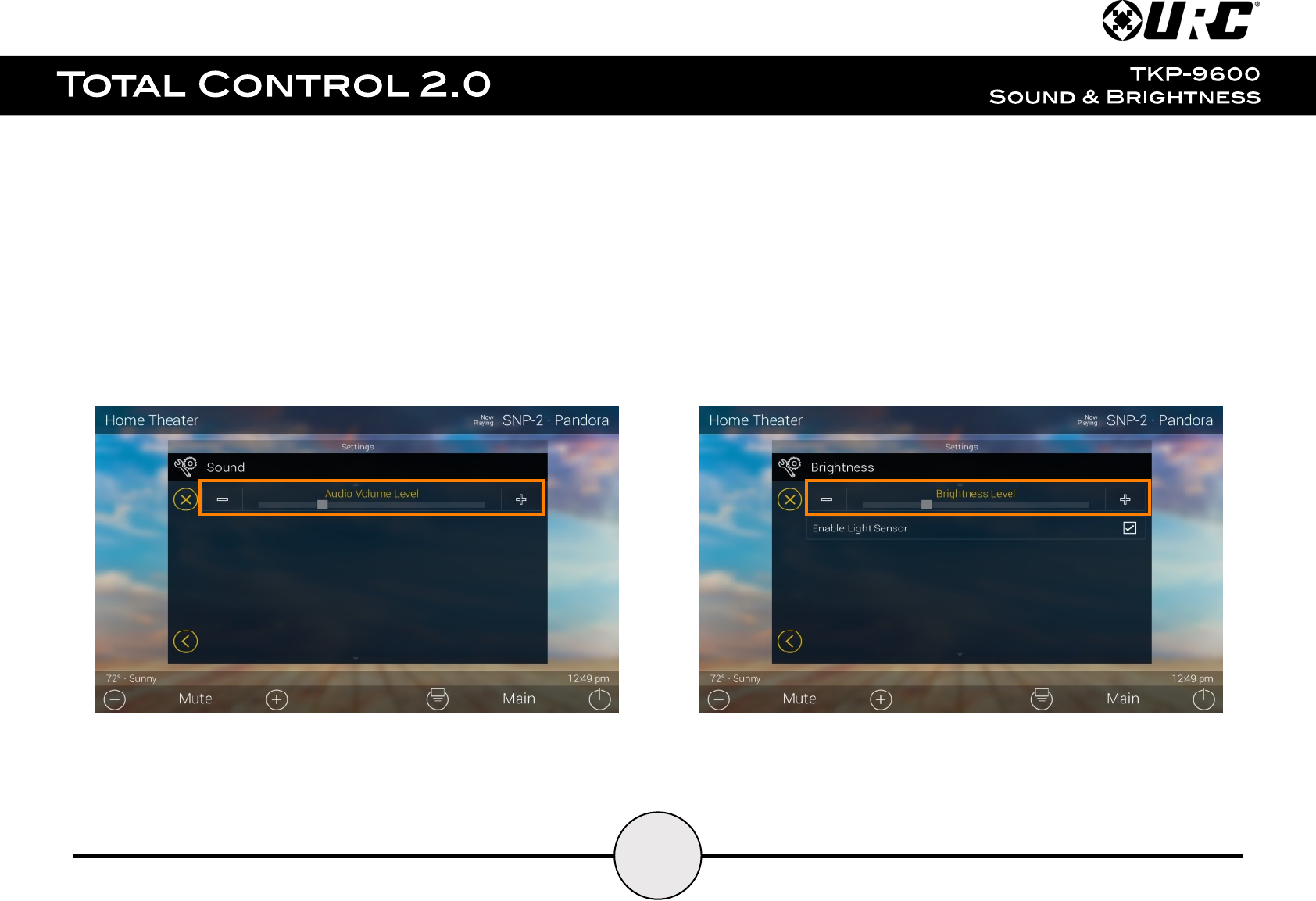
33
Sound:
Press the minus (-) button to lower the TKP-9600’s audio output or press the plus (+)
button to increase the volume.
Additionally, dragging the slider to the right increase the audio output while
dragging it to the left decreases it.
Brightness:
Press the minus (-) button to lower the TKP-9600’s display brightness or press the
plus (+) button to increase the brightness.
Additionally, dragging the slider to the right increase the display brightness while
dragging it to the left decreases it.
●Enable Light Sensor: The TKP-9600 is equipped with an ambient light sensor
that can automatically adjust the display brightness. Check the box to
enable this feature.
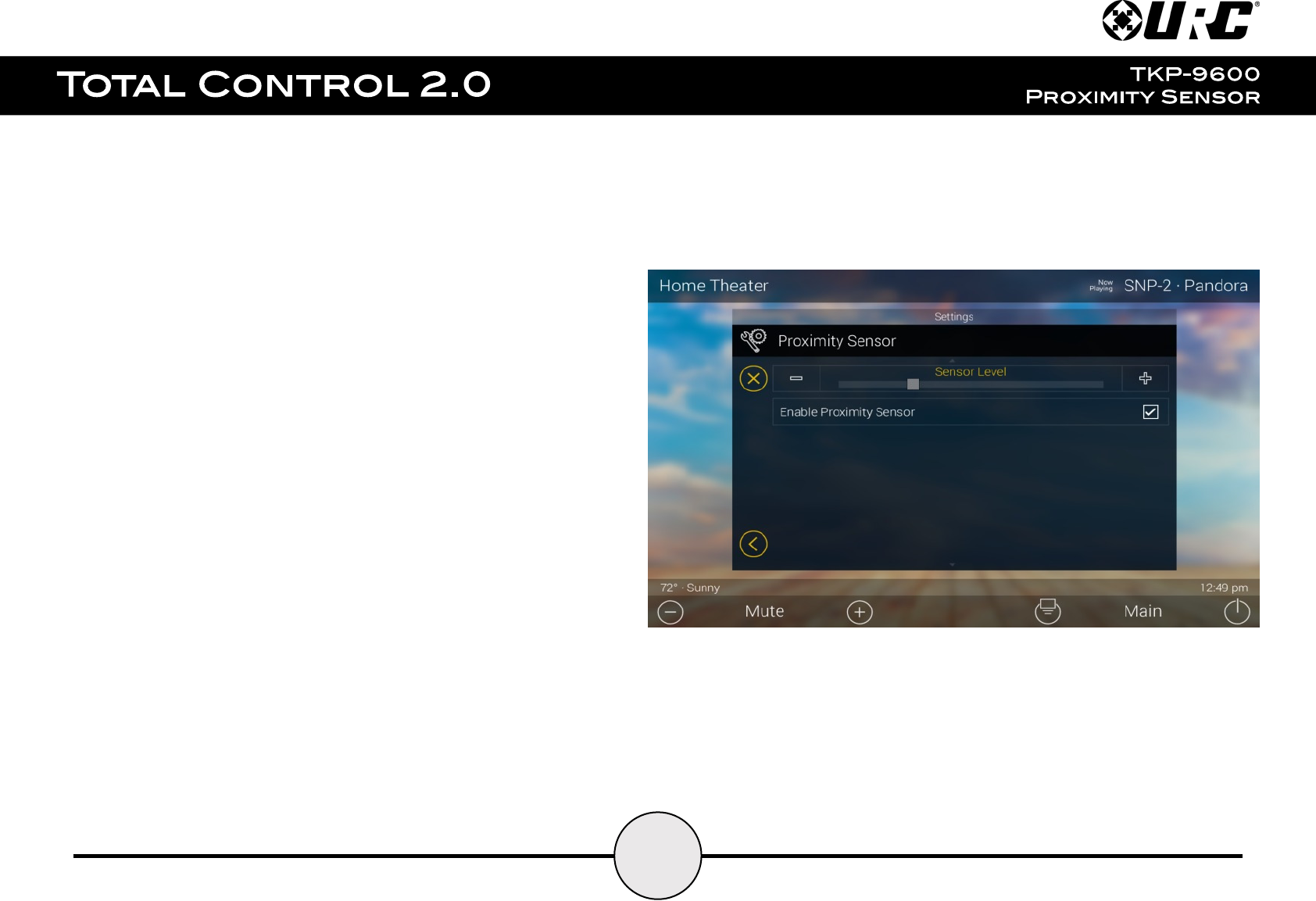
34
Proximity Sensor:
Press the minus (-) button to lower the sensitivity on the TKP-9600’s
Proximity Sensor or press the plus (+) button to increase the sensitivity.
Additionally, dragging the slider to the right increases the sensitivity while
dragging it to the left decreases it. The maximum distance of the proximity
sensor is about three (3) feet.
●Enable Proximity Sensor: By default this check box is enabled.
Uncheck the box to disable the proximity sensor.
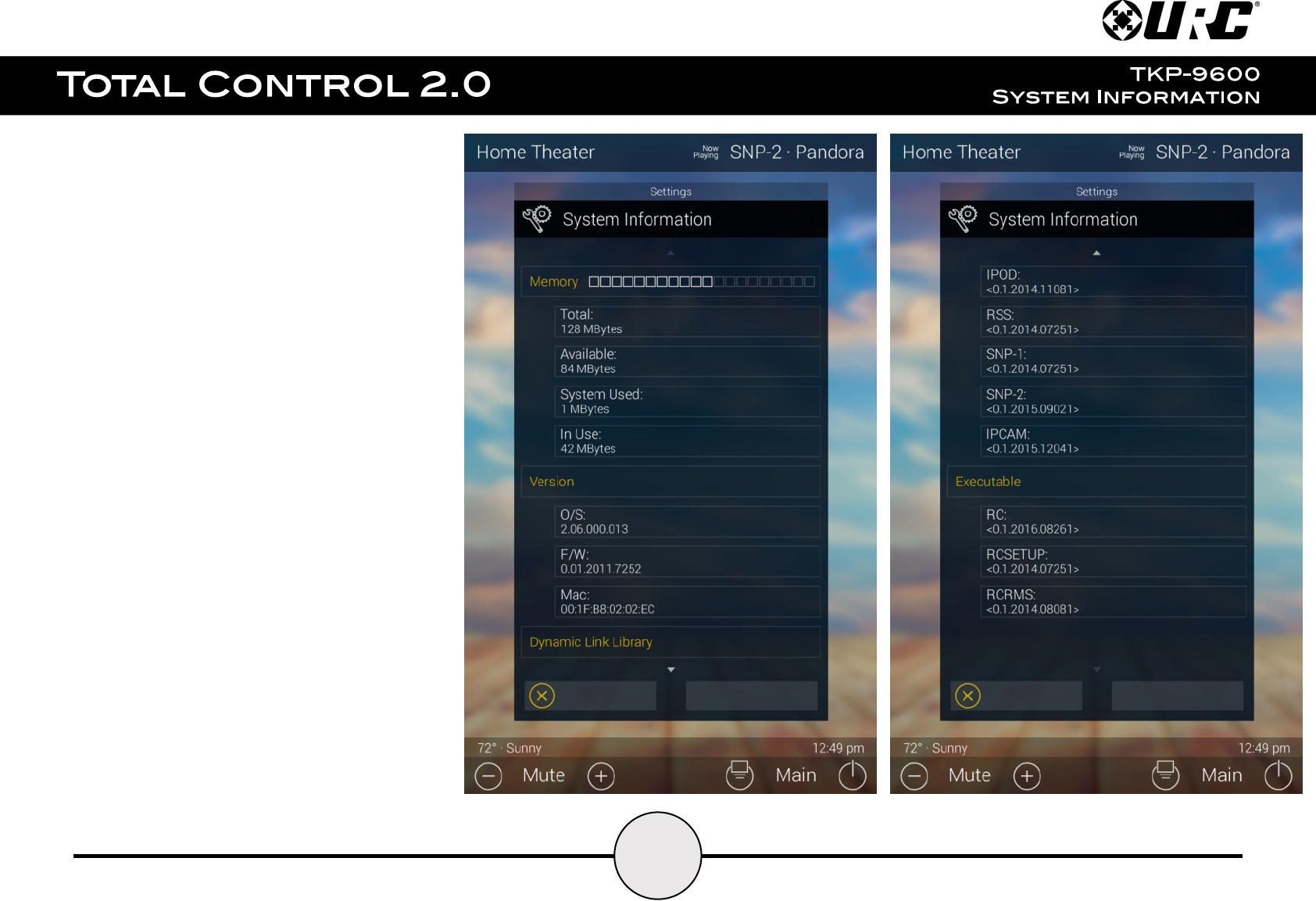
35
System Information:
Although none of the information can be modified.
These System Pages display important information
about the TKP-9600.
These pages are only needed by a custom install
professional or by URC Technical Support.
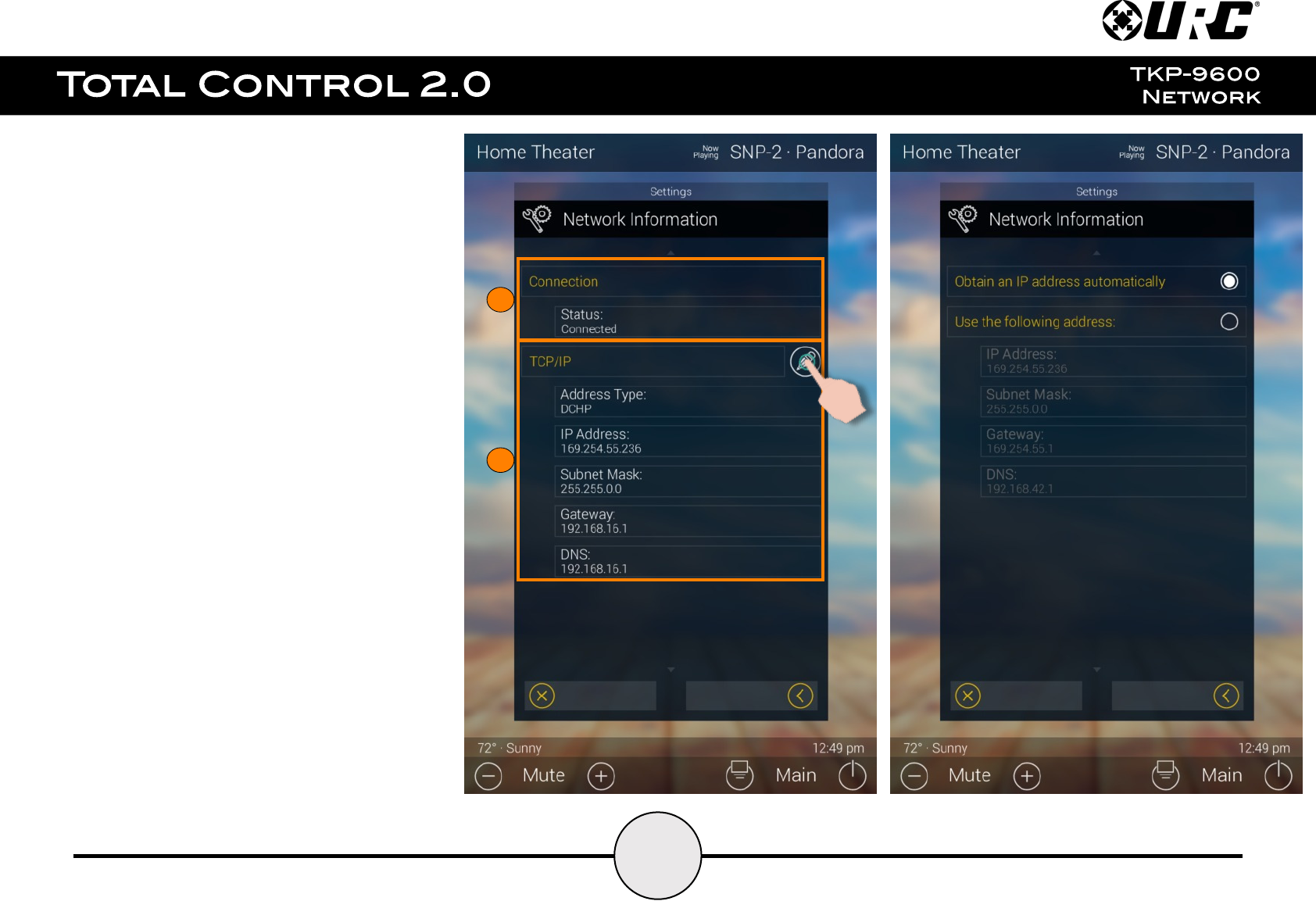
36
Network:
This option displays important information about
the current network.
Caution, these settings should ONLY be changed
by a professional. Entering values without specific
instruction could easily result in the TKP-9600
failing to function correctly.
Here is the information that can be displayed here:
1. Connection: Displays the status of the
network connection, connected or
not connected.
2. TCP/IP: Displays information such as
Address Type (DHCP or Static), IP Address,
Subnet Mask, Gateway, and DNS.
Select the Edit button to reveal additional
options.
●For DHCP select Obtain an IP
Address Automatically.
●For Static select Use the
Following Address. Fill out the
required network settings.
1
2
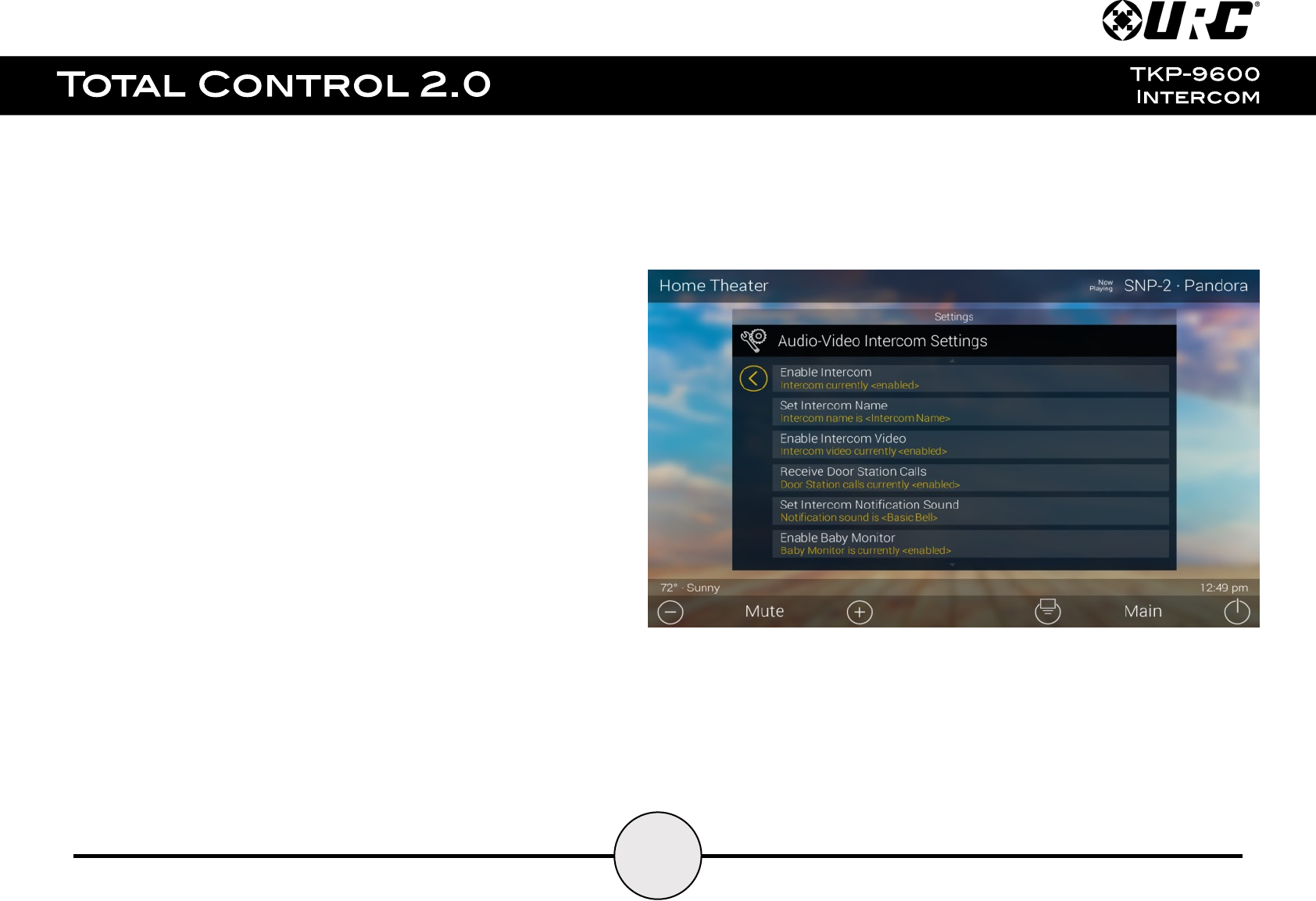
37
Intercom:
The Audio-Video Intercom Settings menu is the location where the Intercom
features must be enabled. By default this feature is disabled, it must be
enabled in order for the TKP-9600 to communicate with other Intercom-
Enabled devices.
●Enable Intercom: Enables the audio intercom function. Once
enabled, the Intercom icon is displayed when dragging down the
Title Bar as see on page 8.
●Set Intercom Name: The label entered here appears on the
Intercom menu of Intercom-Enabled devices in the system.
●Enable Intercom Video: Enables the video intercom function.
●Receive Door Station Calls: If the system is integrating with a 3rd
party door station (DoorBird), this feature must be enabled for the
TKP-9600 to receive door station calls.
●Set Intercom Notification Sound: Allows the user to select a
different tone for intercom calls.
●Enable Baby Monitor: Enables the Baby Monitor function.
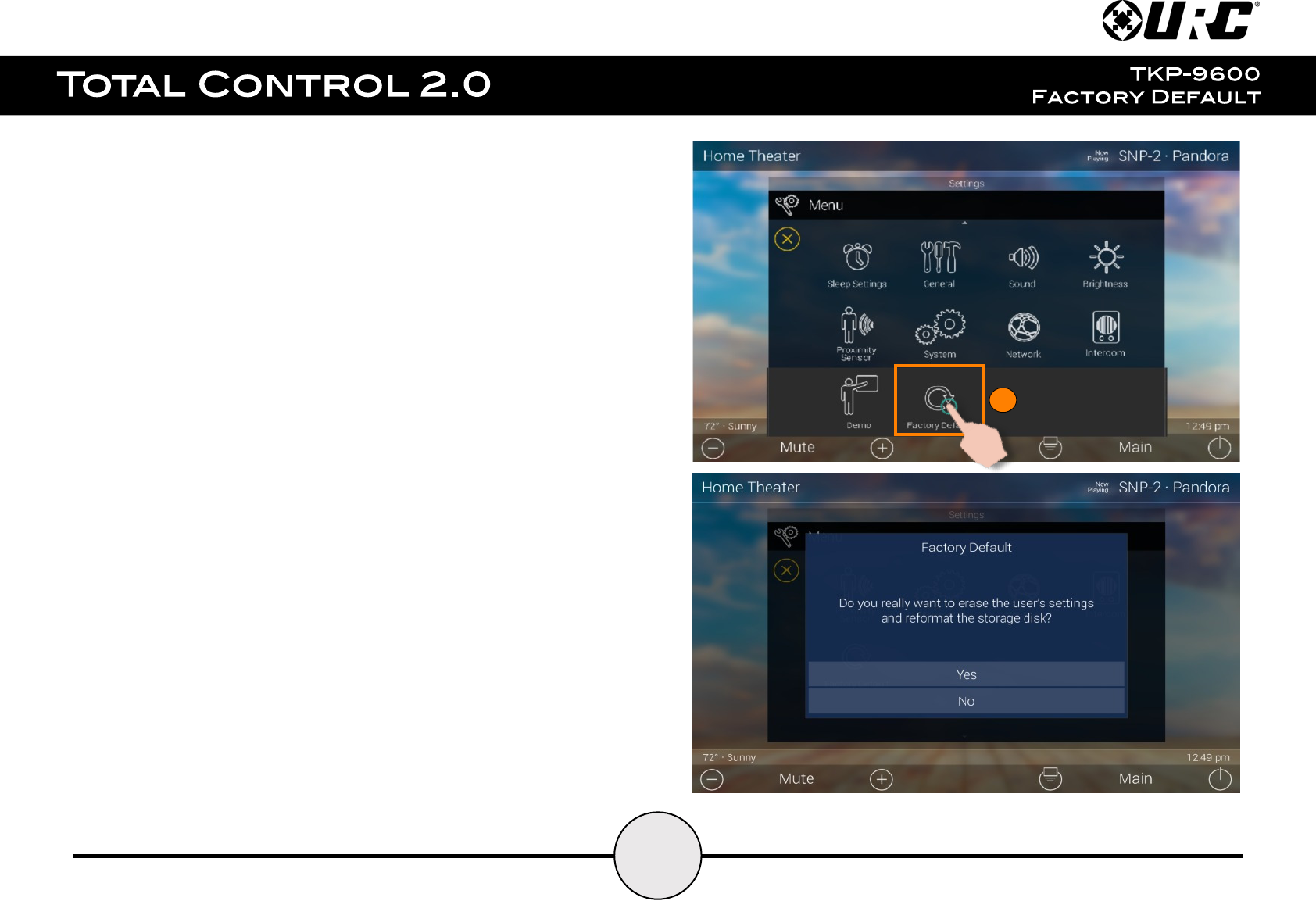
38
Factory Default:
This should only be attempted by a custom install professional that is familiar with
Total Control 2.0 or under instruction from URC Technical Support.
Selecting this option resets the TKP-9600 to its factory state and does not function
until the device is reprogrammed by a custom install professional.
1. Press and hold the Factory Reset button for over five (5) seconds.
2. Select Yes.
1
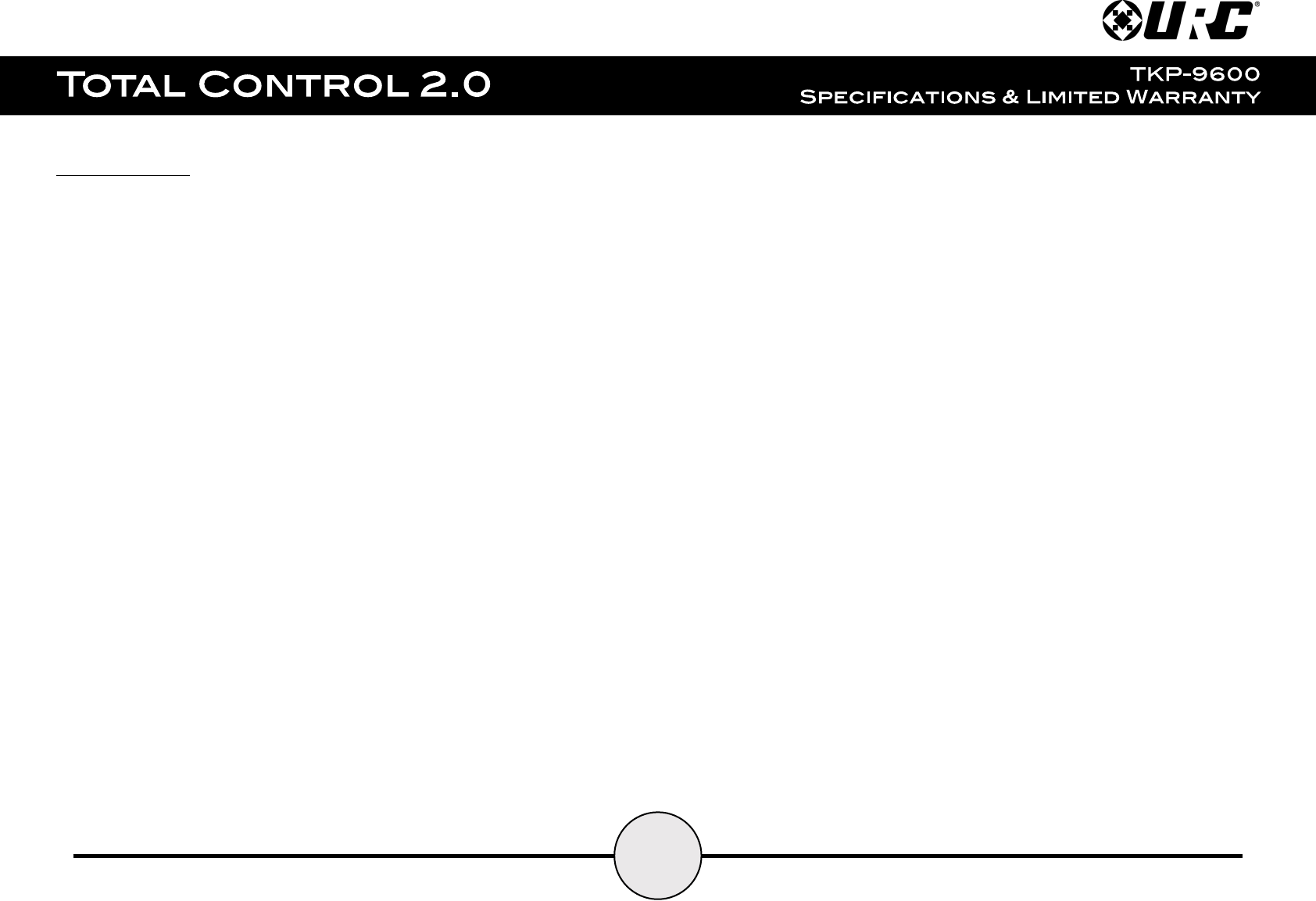
39
Specifications:
These are the technical specifications for the TKP-9600:
Microprocessor: Cortex-A9 Dual 1GHz
Memory: 8GB eMMC, 2GB RAM
Devices: Supports up to 255 devices
Pages: Supports up to 255 pages on each devices
Macro Capability: Up to 255 steps
Network: One 10/100/1000 Ethernet Port (PoE+)
LCD: 10 Inch (1280 x 800)
Weight: 24.7 oz
Size: 10” x 7” x 1.03”
Power: Standard PoE Injector or PoE Switch (purchased separately)
Limited Warranty Statement
1. Limited Warranty and Disclaimers
Universal Remote Control, Inc. (“URC”) warrants that the URC equipment shall be
free from defects in material and workmanship under normal usage for one (1)
year from purchase when such is purchased from URC. This limited warranty is
valid only in the United States of America. URC warrants that the software
will substantially conform in any material respect to its functional specifications at
the time of delivery. URC SHALL NOT BE LIABLE FOR OPERATIONAL, TECHNICAL
OR EDITORIAL ERRORS AND/OR OMISSIONS MADE IN THE URC
DOCUMENTATION. URC DOES NOT WARRANT THAT THE URC SOFTWARE IS
BUG-FREE OR ERROR FREE OR THAT THERE ARE NO ERRORS/BUGS IN THE URC
SOFTWARE.
URC warrants that at the time of purchase the URC equipment and the URC
software complied with all applicable regulations and policies of the Federal
Communications Commissions (“FCC”) regarding electromagnetic interference
caused by electronic/computing devices and to the extent that the URC equipment
and/or the URC software fails to so comply, URC shall, at its own expense, take all
reasonable measures to promptly cause such to comply.
URC equipment purchases from other than an authorized URC dealer or
distributor are without warranty.
THIS LIMITED WARRANTY DOES NOT COVER TECHNICAL ASSISTANCE FOR
HARDWARE OR SOFTWARE USAGE EXCEPT AS EXPRESSLY PROVIDED FOR
HEREIN, THE EQUIPMENT, SOFTWARE AND DOCUMENTATION OF URC ARE
SUPPLIED “AS IS” WITHOUT ANY WARRANTY, EXPRESS, STATUTORY OR
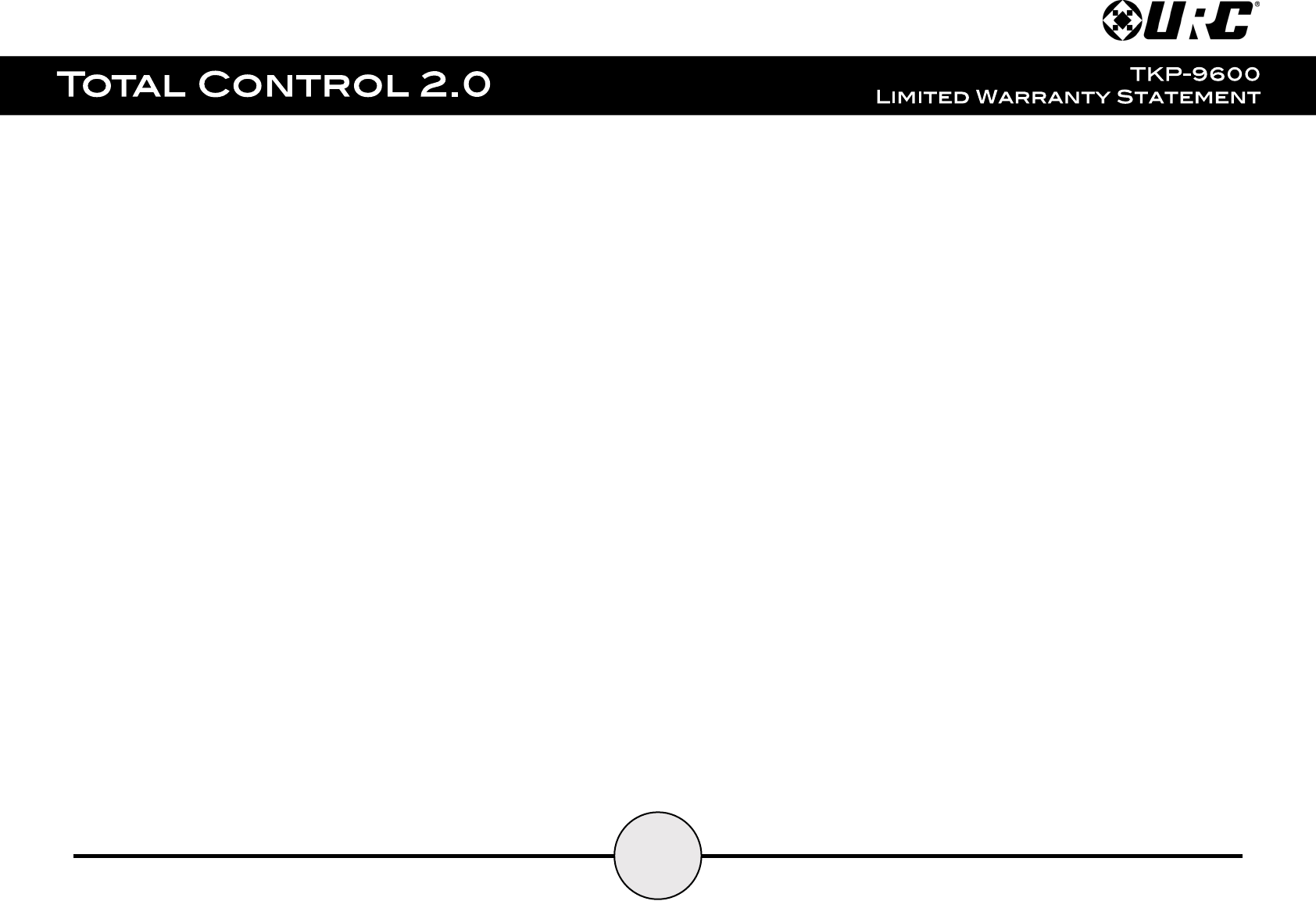
40
IMPLIED, OF ANY KIND. TO THE MAXIMUM EXTENT PERMITTED BY APPLICABLE
LAW, URC EXPRESSLY DISCLAIMS ALL WARRANTIES, EXPRESS, STATUTORY OR
IMPLIED, INCLUDING BUT NOT LIMITED TO THE WARRANTIES OF
MERCHANTABILITY AND FITNESS FOR A PARTICULAR PURPOSE. URC DOES NOT
WARRANT, GUARANTEE, OR MAKE ANY REPRESENTATIONS REGARDING THE
USE OF, OR THE RESULTS OF THE USE OF, THE EQUIPMENT, SOFTWARE OR
DOCUMENTATION IN TERMS OF CORRECTNESS, ACCURACY, RELIABILITY OR
OTHERWISE. EXCEPT AS EXPRESSLY PROVIDED FOR HEREIN, TECHNICAL
SERVICES ARE SUPPLIED “AS IS”, WITHOUT ANY WARRANTY, EXPRESS,
STATUTORY OR IMPLIED, OF ANY KIND. TO THE MAXIMUM EXTENT PERMITTED
BY APPLICABLE LAW, URC EXPRESSLY DISCLAIMS ALL WARRANTIES, EXPRESS,
STATUTORY OR IMPLIED, INCLUDING BUT NOT LIMITED TO THE WARRANTIES
OF QUALITY OR REASONABLE SKILL AND CARE, OR OUTCOME OR RESULTS.
WITHOUT IN ANY WAY LIMITING THE GENERALITY OF THE OTHER PROVISIONS
HEREIN, WARRANTY DOES NOT COVER: (I) DAMAGE FROM MISUSE, NEGLECT
OR ACTS OR NATURE, (II) MODIFICATIONS, (III) INTEGRATION WITH THIRD PARTY
CONTENT (IV) BEYOND THE WARRANTY PERIOD AND/ OR FAILURE TO FOLLOW
URC WARRANTY CLAIM PROCEDURE.
The warranty limitations and warranty disclaimers may not apply to end user in
whole or in part, where such are restricted or excluded by applicable law and such
shall apply to the maximum extent permitted by applicable law.
In the event of any warranty claim, URC will, at its sole option, repair the URC
equipment using new or comparable rebuilt parts, or exchange the URC equipment
for new or rebuilt equipment. In the event of a defect, these are the end user’s
exclusive remedies.
All the URC equipment returned for service, exchange or repair require an RGA
number. To obtain an RGA number, you must complete a Return Request Form
which you may obtain by calling (914) 835-4484 or contacting URC at
returnrequest@universalremote.com. To obtain warranty service, end user must
deliver the URC equipment, freight prepaid, in its original packaging or packaging
affording adequate protection to URC at 420 Columbus Avenue, Valhalla, NY
10595. It is end user’s responsibility to backup any macro programming, artwork,
software or other materials that may have been programmed into the unit. It is
likely that such data, software, or other materials will be lost during service and
URC will not be responsible for any such damage or loss. A dated purchase
receipt, bill of sale, installation contract or other verifiable proof of purchase is
required. For the URC equipment support and other important information, please
visit URC's website available at www.universalremote.com or call the Customer
Service Center at (914) 835-4484.
This limited warranty only covers the URC equipment issues caused by defects in
material or workmanship during ordinary consumer use. It does not cover product
issues caused by any other reason, including but not limited to product issues due
to commercial use, acts of God, third-party installation, misuse, limitations of
technology, or modification of or to any part of the URC equipment. This limited
warranty does not cover the URC equipment sold as used, as is, refurbished, so
called "B stock" or consumables (such as batteries). This limited warranty is invalid
if the factory applied serial number has been altered or removed from the URC
equipment. This limited warranty specifically excludes the URC equipment sold by
unauthorized resellers.
With the exception of URC’s IR-only, broad-based consumer remotes, none of Page
36 URC’s PC programmable remotes or any of our Total Control® whole-house
equipment are authorized for online internet sales. Buying URC’s PC programmable
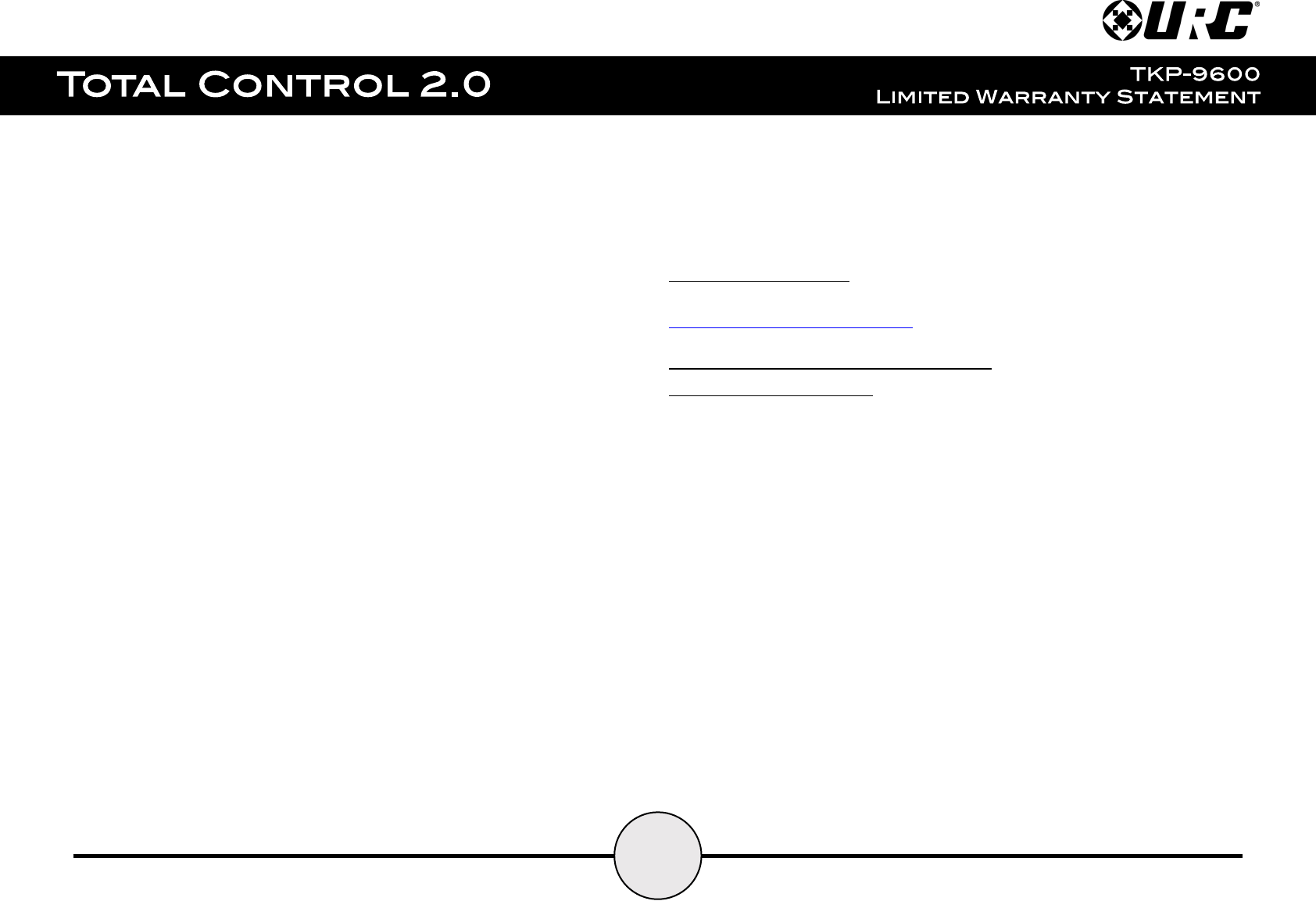
41
remotes or any of our Total Control® whole-house equipment online means
buying equipment that does not have a URC’s limited warranty. Such equipment is
not eligible for URC tech support or software support, either.
2. URC’s Limitations of Liability
IN NO EVENT SHALL URC BE LIABLE FOR INDIRECT, SPECIAL, INCIDENTAL,
EXEMPLARY, PUNITIVE OR CONSEQUENTIAL DAMAGES OF ANY KIND OR LOSS
OF PROFITS OR BUSINESS OPPORTUNITY, EVEN IF URC IS ADVISED OF THE
POSSIBILITY OF SUCH DAMAGES.
IN NO EVENT SHALL URC BE LIABLE FOR LOSS OF OR DAMAGE TO DATA,
COMPUTER SYSTEMS OR COMPUTER PROGRAMS. URC’S LIABILITY, IF ANY, FOR
DIRECT DAMAGES OF ANY FORM SHALL BE LIMITED TO ACTUAL DAMAGES,
NOT IN EXCESS OF AMOUNTS PAID BY END USER FOR THE URC EQUIPMENT.
IN NO EVENT SHALL URC BE LIABLE FOR ANY EVENTS BEYOND ITS CONTROL,
INCLUDING ANY INSTANCE OF FORCE MAJEURE. IN NO EVENT SHALL URC BE
LIABLE FOR THE ACTS OR OMISSIONS OF END USER OR ANY THIRD PARTY.
THE LIMITATIONS OF LIABILITY MAY NOT APPLY TO END USER IN WHOLE OR IN
PART, WHERE SUCH ARE RESTRICTED LIMITED OR EXCLUDED BY APPLICABLE
LAW AND SUCH SHALL APPLY TO THE MAXIMUM EXTENT PERMITTED BY
APPLICABLE LAW.
URC SHALL NOT BE HELD RESPONSIBLE FOR THE STATEMENTS MADE BY
OTHERS.
SOME STATES OR JURISDICTIONS DO NOT ALLOW THE EXCLUSION OR
LIMITATION OF INCIDENTAL OR CONSEQUENTIAL DAMAGES, OR ALLOW
LIMITATIONS ON HOW LONG AN IMPLIED WARRANTY LASTS, SO THE ABOVE
LIMITATIONS OR EXCLUSIONS MAY NOT APPLY TO END USER. THIS LIMITED
WARRANTY GIVES END USER SPECIFIC LEGAL RIGHTS AND END USER MAY
HAVE OTHER RIGHTS WHICH VARY FROM STATE TO STATE OR JURISDICTION TO
JURISDICTION.
End User Agreement
The terms and conditions of the End User Agreement available at
www.universalremote.com/eua.php shall apply.
Federal Communication Commission
Interference Statement
This equipment has been tested and found to comply with the limits for a Class B
digital device, pursuant to part 15 of the FCC Rules. These limits are designed to
provide reasonable protection against harmful interference in a residential installation.
This equipment generates, uses and can radiate radio frequency energy and, if not
installed and used in accordance with the instructions, may cause harmful interference
to radio communications. However, there is no guarantee that interference will not
occur in a particular installation. If this equipment does cause harmful interference to
radio or television reception, which can be determined by turning the equipment off
and on, the user is encouraged to try to correct the interference by one more of the
following measures:
●Reorient or relocate the receiving antenna.
●Increase the separation between the equipment and receiver.
●Connect the equipment into an outlet on a circuit different from that to which
the receiver is connected.
●Consult the dealer or an experienced radio/TV technician for help.
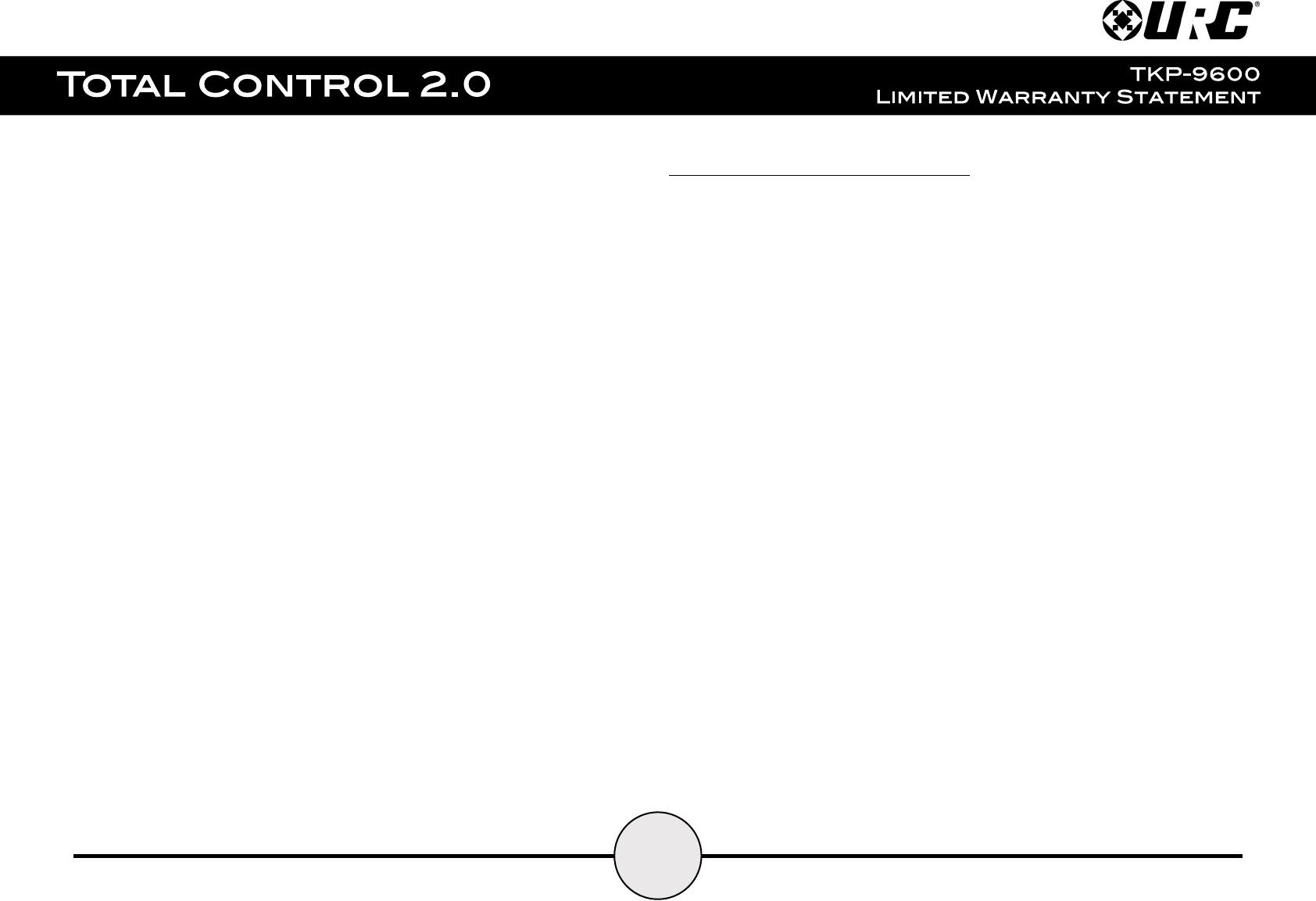
42
Warning!
Changes or modifications not expressly approved by the manufacturer could void
the user's authority to operate the equipment.
Note : The manufacturer is not responsible for any Radio or TV interference caused
by unauthorized modifications to this equipment. Such modifications could void
the user's authority to operate the equipment.
FCC Caution
This device complies with Part 15 of the FCC Rules. Operation is subject to the
following two conditions: (1) this device may not cause harmful interference, and
(2) this device must accept any interference received, including interference that
may cause undesired operation.
Any changes or modifications not expressly approved by the party responsible for
compliance could void the authority to operate equipment.
Regulatory Information to the user
●CE conformity Notice
Products with “CE” marking comply EMC Directive 2014/30/EU issued by the
commission of the European Community.
1. EMC Directive
❑Emission : EN 55032
❑Immunity : EN 55024
●Declaration of Conformity
“Hereby, Universal Remote Control Inc. declares that this TKP-9600 is in
compliance with the Essential requirements
This product herewith complies with the requirements of EMC Directive 2014/30/EU
issued by the commission of the European Community:
❑EMC Directive 2014/30/EU
✔EN 55032
✔EN 55024
Testing Laboratory: GUMI University EMC Center